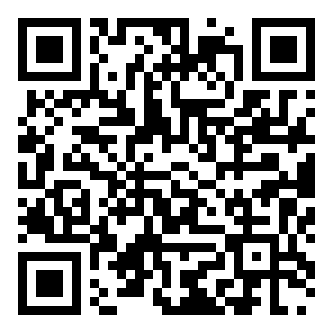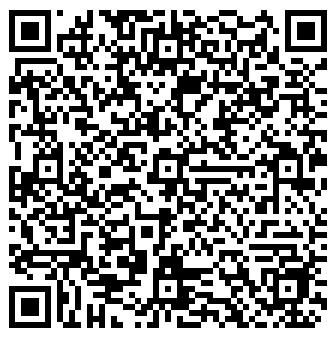Blogs & Articles: Craig Wright’s Tulip Trust List Forgery — A Full History 🔗 1 year ago

- Category: Blogs & Articles | MyLegacyKit on Medium
- Author(s): MyLegacyKit
- Published: 21st December 2022 10:19
Craig Wright’s Tulip Trust List Forgery — A Full History
From the prelude to the ‘Shadders Bug’ to the aftermath of the 145 signings
 Source: Twitter user BitcoinMemeHub
Source: Twitter user BitcoinMemeHub
Written by Arthur van Pelt
ABOUT EDITS to this article: as more material may become available after the publication of this article, it could have edits and updates every now and then. In that sense, this article can be considered a work in progress, and become a reference piece for years to come.
With eternal thanks to Twitter user “Tak_Horigoshi” who provided the inspiration for this article with his beautiful December 2021 tweetstorm about how the credibility of Craig Wright’s Tulip Trust list — made public by accident, then quickly signed 145 times “Craig Steven Wright is a liar and a fraud” in May 2020 during the Kleiman v Wright lawsuit — can be checked against other lists and expert witness findings.
This article will expand further on Tak_Horigoshi his thread, which you will find verbatim at the heart of it.
The Prelude (2014)
The Tulip Trust saga has its roots early 2014, when Craig Wright — covering up for his previous lies of late 2013 about owning and controlling handfuls of random Bitcoin rich list addresses — started to lie about having invented Bitcoin, and as such having been an early Bitcoin miner, to the Australian Taxation Office (ATO) and others like the Kleiman estate, who will return with a blow a bit later in this article. But first, let’s take some snippets from “Faketoshi, The Early Years — Part 2” to see what happened in this timeframe.
“In 2009 the mining of bitcoin commences.” and “2011, bitcoin was transferred overseas.” are quotes that we can find in a February 18, 2014 ATO hearing transcript when tax lawyer Andrew Sommer helped to get traction for the Faketoshi story on behalf of Craig Wright, and introduced us to the narrative that would ultimately become the Tulip Trust.
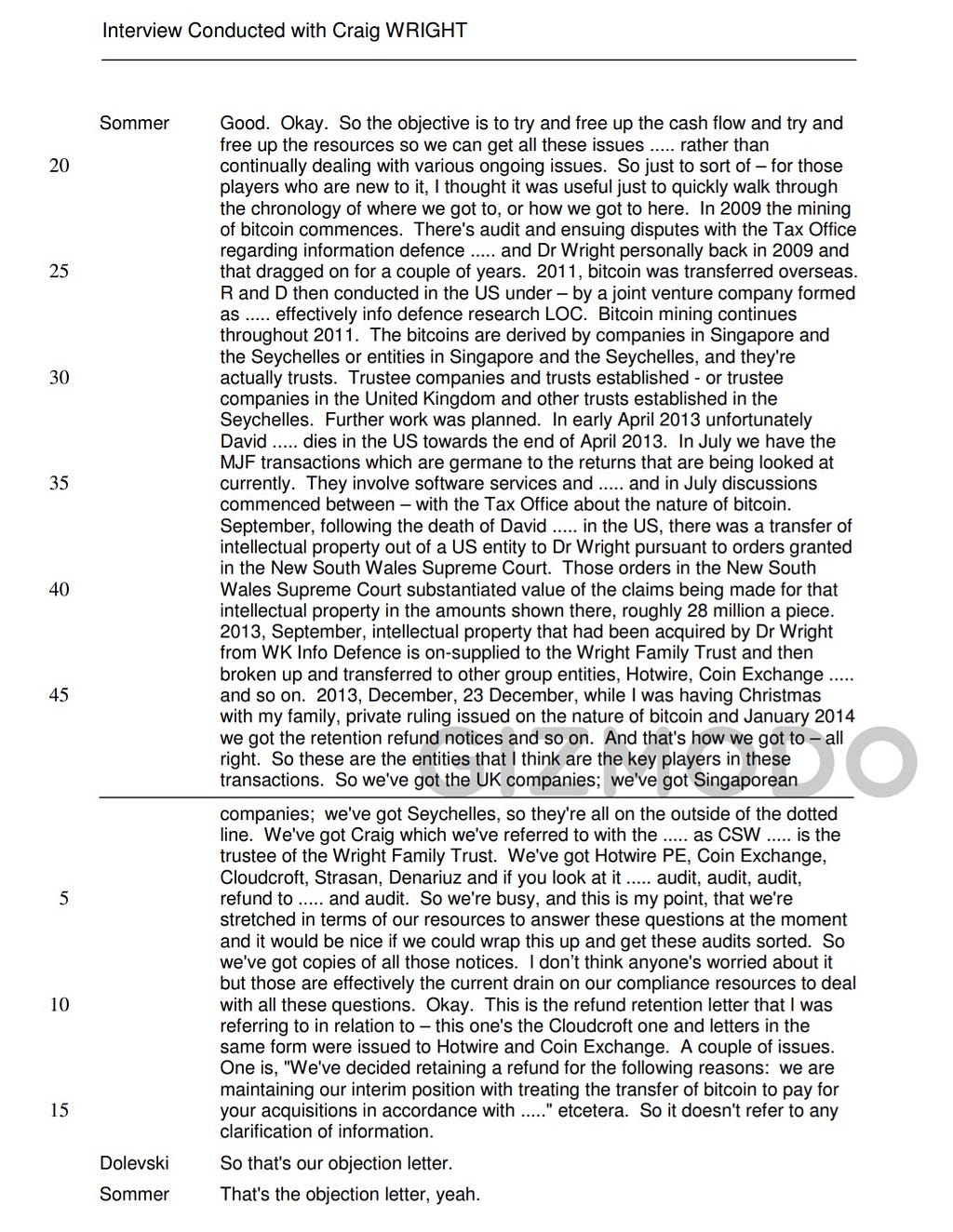
More clues are offered by Craig’s accountant John Chesher, who on February 26, 2014 falsely declared to the ATO on behalf of Craig Wright that “Craig Wright had mined a lot of Bitcoins. […] Craig had gotten approximately 1.1 million Bitcoins.”.
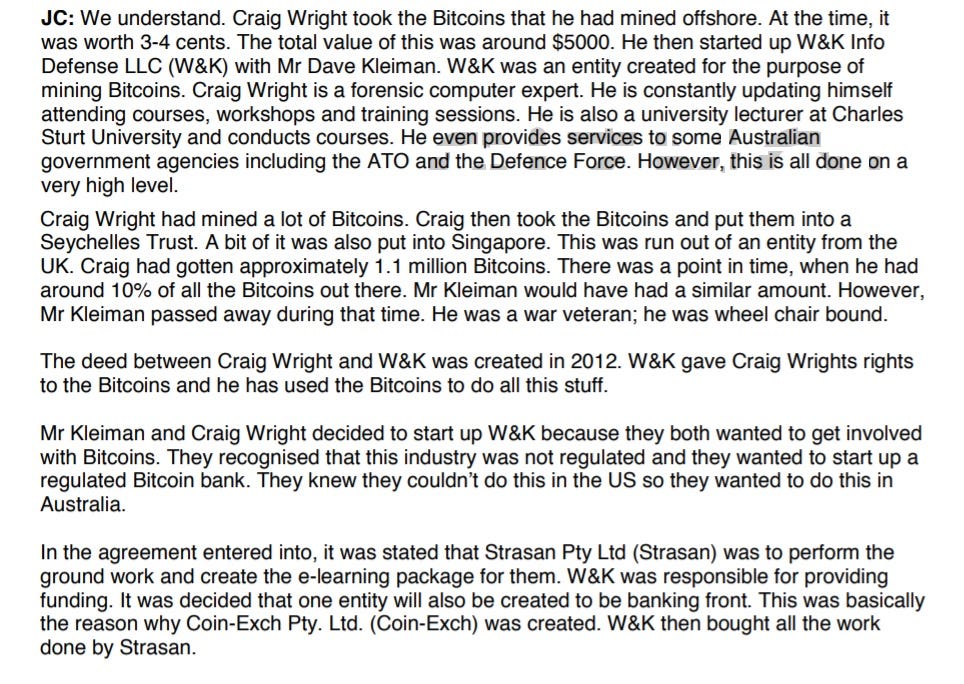
The stage is now set for Craig Wright to come up with his first line of backdated forgeries related to the Tulip Trust. Forgeries created to further his multi million Australian tax fraud.
Firstly, on October 17, 2014 Craig bought an empty off-the-shelf Seychelles company called Tulip Trading Limited from Abacus (Seychelles) Limited for $3,650.00. Tulip Trading is a company that was raised in 2011 and put on the shelves of Abacus, which made it extremely convenient for Craig to throw some backdated forgeries at it.
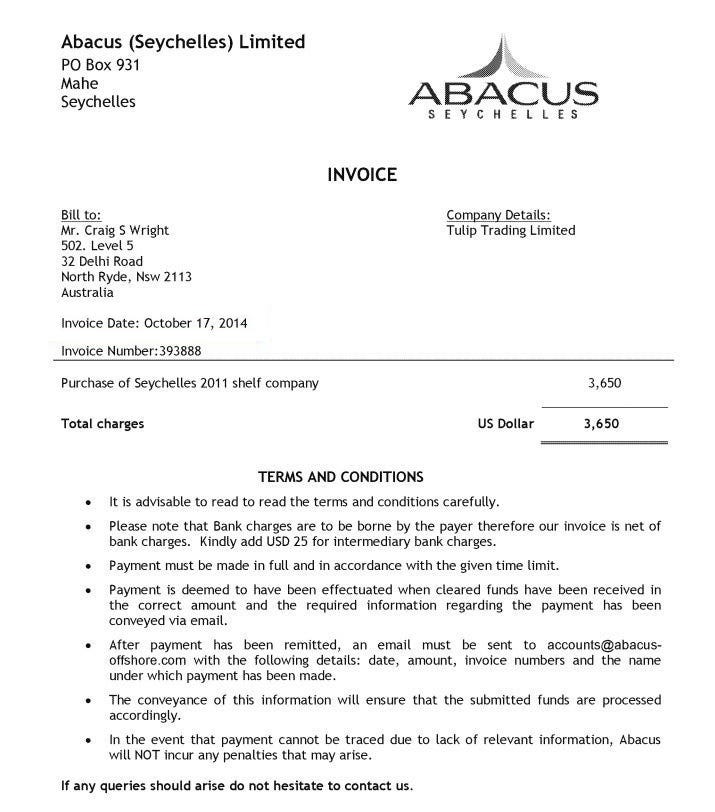 Source: CourtListener
Source: CourtListener
Secondly, Craig Wright also bought a domain called TulipTrading.net in the same month (actually, on the same day even). And thirdly, at the same time he created several backdated forgeries, like emails, deeds and contracts, to fake a non-existing line of events, as if this Tulip Trust thing was always part of his Bitcoin dealings before October 2014.
It wasn’t, of course.
One of those backdated forgeries is a fake contract created by Craig Wright on October 17, 2014 but it is desperately trying to imply it was set up by Dave Kleiman in June 2011. In this contract (source: CourtListener) we will find the 1.1 million bitcoin that John Chesher mentioned on behalf of Craig Wright in February of this year.
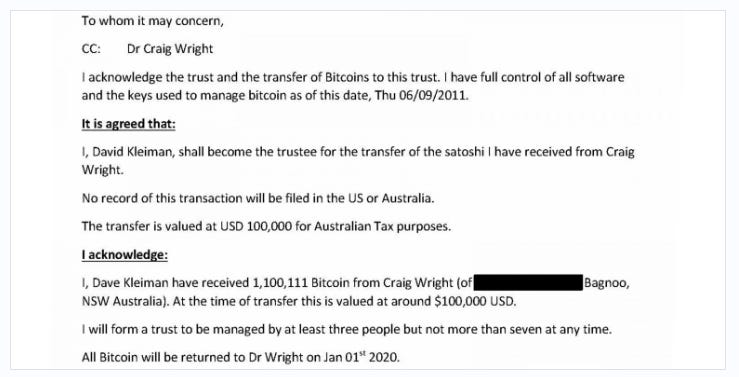 Why this is a Craig Wright made forgery is explained in detail by WizSec.
Why this is a Craig Wright made forgery is explained in detail by WizSec.
And Craig Wright literally admitting he created that forgery after drinking three bottles of wine is nothing short of hilarious, of course. But this is exactly what he did during the hodlonaut v Wright trial in September 2022.
Peter Scott-Morgan 13%er on Twitter: "Good afternoon.In typical fashion, @Dr_CSWright put's both feet in his mouth under oath,#BSV'ers hand-wave it away and #Bitcoin 'ers chuckle. pic.twitter.com/iUWg5XiEZg / Twitter"
Good afternoon.In typical fashion, @Dr_CSWright put's both feet in his mouth under oath,#BSV'ers hand-wave it away and #Bitcoin 'ers chuckle. pic.twitter.com/iUWg5XiEZg
And with another forgery, backdated to October 23, 2012, Craig Wright created the Tulip Trust from thin air in October 2014. From now onward, this fake Tulip Trust is supposed to be a partnership between the Seychelles based companies Wright International Investments Ltd (supposedly holding Craig’s ‘mined’ bitcoin and Craig’s non-existing Bitcoin Copyright and Intellectual Property) and Tulip Trading Ltd (supposedly holding Craig’s ‘bought’ bitcoin).
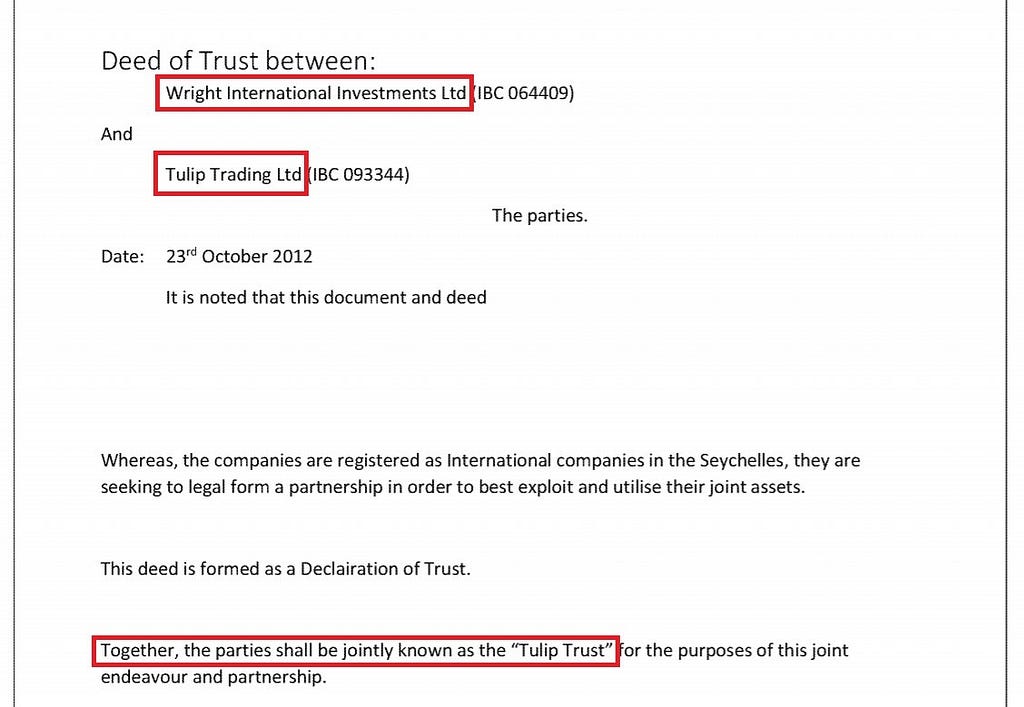 Source: CourtListener
Source: CourtListener
Another 2014 forgery, backdated to October 24, 2012, mentions the 821,050 bitcoin that Craig Wright claims to have mined between January 2009 and August 2010. Only page 1 is shown, the full document can be found in the CourtListener court docket of the Kleiman v Wright lawsuit.
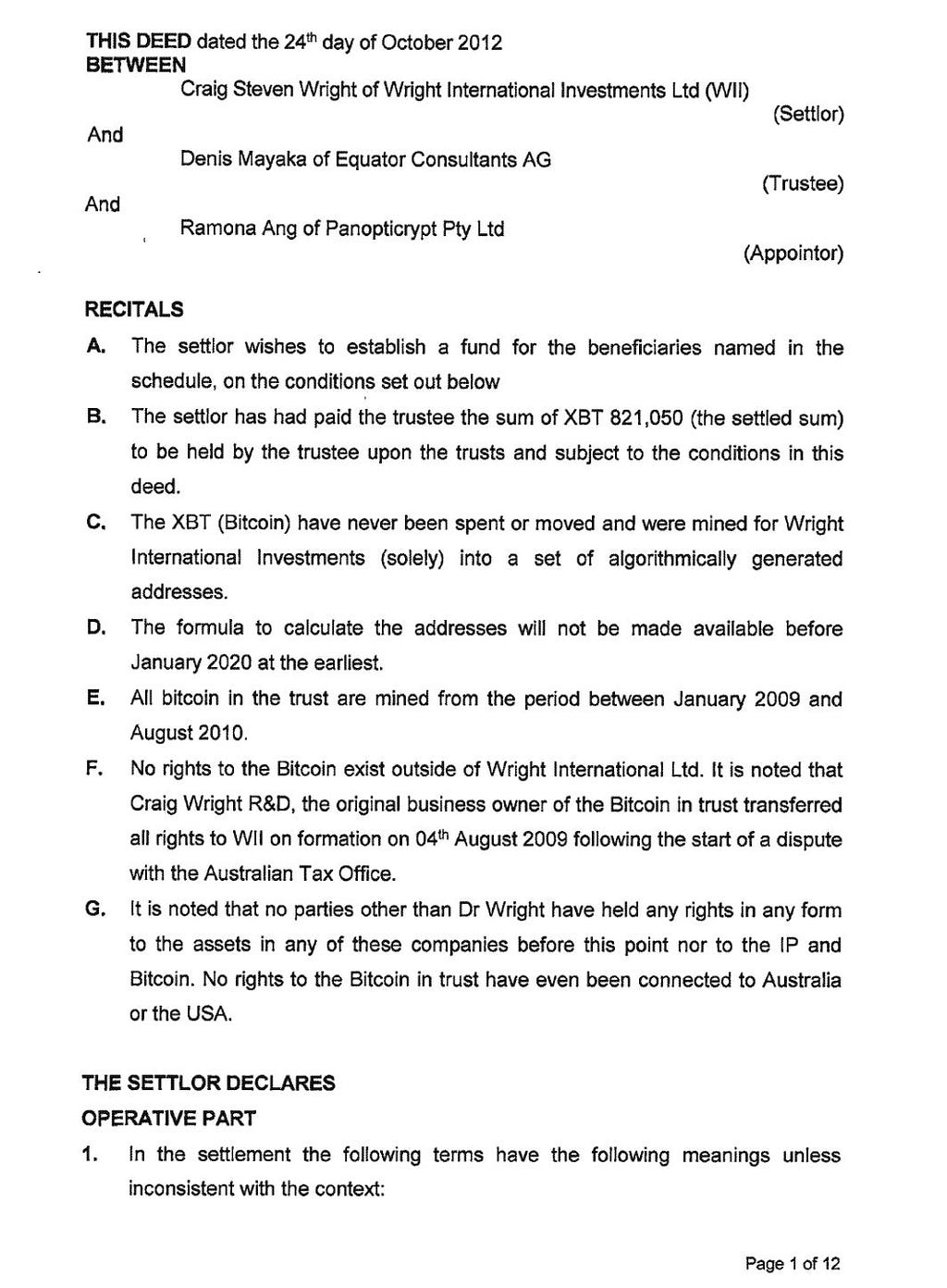 Note that the XBT ticker was only in use starting August 2013 on the Bloomberg terminals
Note that the XBT ticker was only in use starting August 2013 on the Bloomberg terminals
Let’s be perfectly clear again about all these false claims mentioned in these Craig Wright forgeries: there has NEVER been any proof of any Bitcoin mining done by Craig Wright, whether it be in 2009, 2010, 2011, 2012 or 2013. The same goes for his false claims of having bought large quantities of Bitcoin (and the threshold is 50 here) in that same period. Every lie and every forgery that Craig Wright provided over the years since 2014, the year that his Satoshi Nakamoto cosplay started, to support these wild claims has been, without any exception, thoroughly debunked as such by either the ATO, several forensic experts who acted as witnesses in lawsuits with Craig Wright involved, or by members of the Bitcoin — and Craig Wright debunk community.
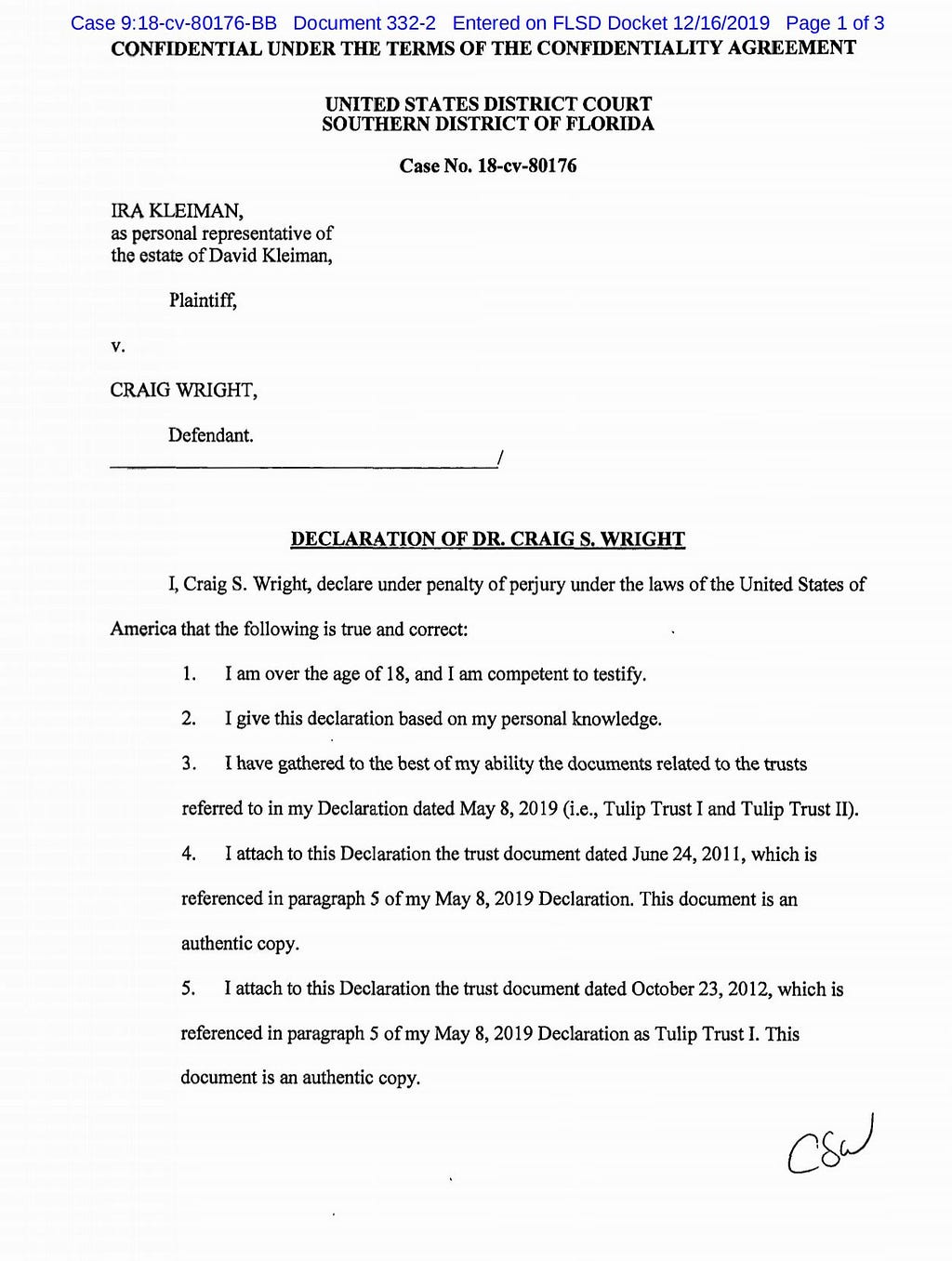
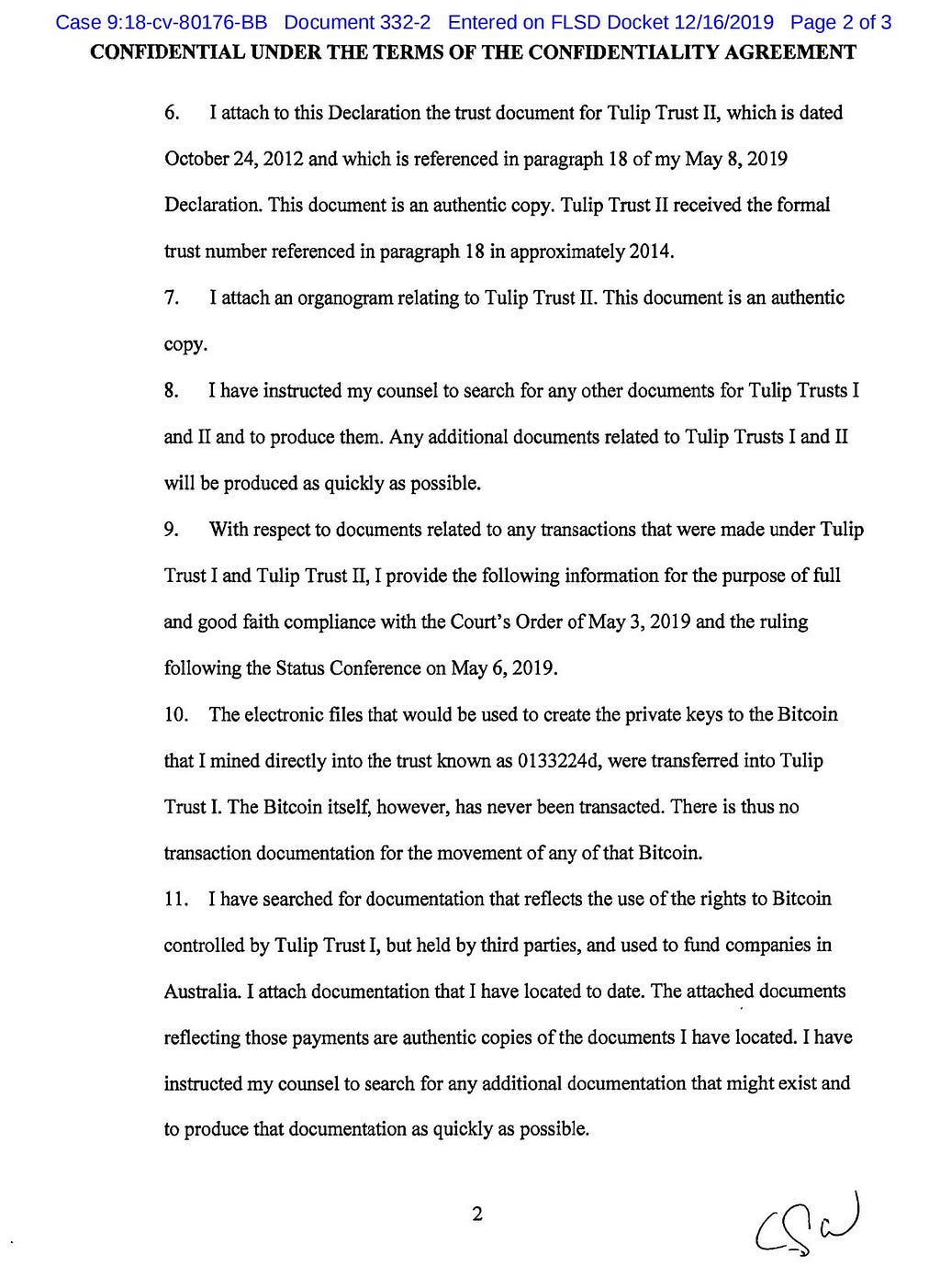
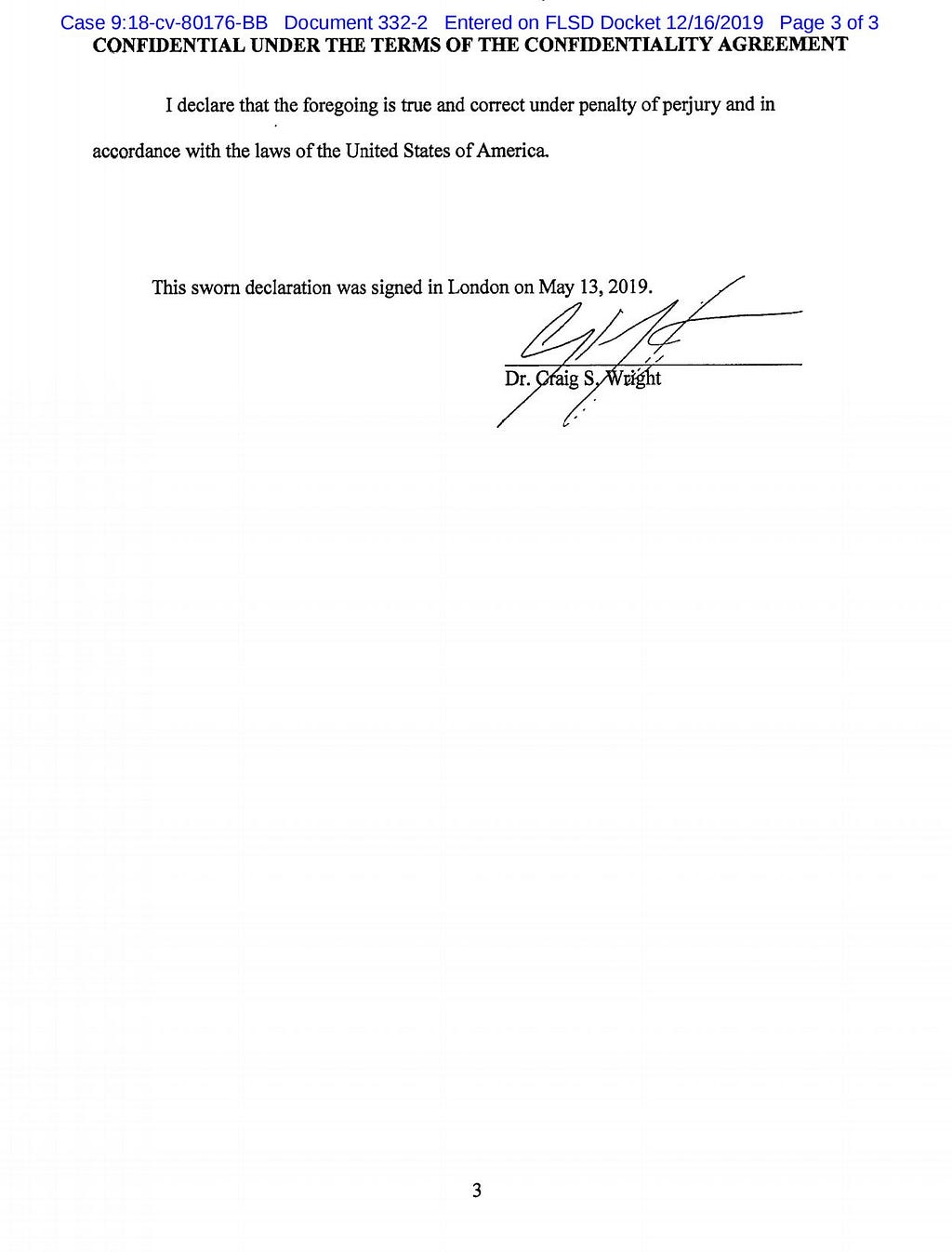 Example of a thoroughly false Craig Wright declaration found in the Kleiman v Wright lawsuit
Example of a thoroughly false Craig Wright declaration found in the Kleiman v Wright lawsuit
The Kleiman v Wright lawsuit (2018–2021)
We are now going to make a jump to the year 2019. Ira Kleiman, the brother of (dead, as he passed away in April 2013) Dave Kleiman, had dragged Craig Wright into court in the USA the year before, basically accusing him of all types of fraud that Craig performed after April 2013, but with his deceased brother involved. Over the course of the lawsuit, Ira (who appears to have believed most of the false Satoshi Nakamoto claim of Craig Wright) and his counsel, of course, also came across the bitcoin that Craig claimed to own in his Tulip Trust.
A “Motion to Compel” of Ira Kleiman dated June 11, 2019 explains what happened and had happened at this point in time. Some (mildly rewritten for readability purposes) quotes from that motion:
On March 14, 2019 (and confirmed again on May 3, 2019) the Court in Miami, Florida ordered Craig Wright to comply with a bitcoin holdings discovery request dating back to July 2018, although the Court did limit the time scope of the request to the bitcoin that Craig owned as of December 31, 2013. But nearly nine months after Ira Kleiman’s initial request of July 2018 and after no less than four discovery hearings before the Court in Miami, Craig finally moved for a protective order where he claimed for the first time that he “transferred ownership of all his Bitcoin into a blind trust” in 2011. So Craig’s motion requested the Court to reconsider its order directing him to identify all his pre-2014 bitcoin because he didn’t have that information anymore.
However, on May 3, 2019, Court Miami rejected Craig’s motion, stating that “although Craig Wright makes the conclusory statement that it would be unduly burdensome to produce a list of his bitcoin holdings as of December 31, 2013, this conclusion is not supported by the facts”. The Court also identified a fatal flaw in Craig’s argument that it wasn’t possible to produce this list, because he could obtain it “from the trustee of the blind trust”. The Court held that while Craig claimed he could not provide a list of his pre-2014 bitcoin, this “evidence can be obtained through other means, which the Court will authorize Plaintiffs to use”. The Court then ordered Craig to “produce all transactional records of the blind trust, including but not limited to any records reflecting the transfer of bitcoin into the blind trust in or about 2011”.
In response to the Court’s order, Craig Wright produced two sworn statements, copies of various trust instruments, and a statement from the purported trustee re-attaching a trust instrument. The trust instruments purported to show that Craig transferred 1,100,111 bitcoin to Dave Kleiman in June of 2011. Craig’s sworn statements and trust instruments then claim that “in October 2012 a formal trust document was executed”. This trust document purported to show that 821,050 bitcoin was paid to the trustee in October 2012. But besides simply stating these astronomical numbers of bitcoin transferred, none of Craig’s statements or trust documents identify the specific bitcoin addresses transferred into the blind trusts, nor had he produced any accounting records of what the trusts have done with the massive fortune of bitcoins since their alleged transfer in 2011. As Craig has stated many times, bitcoin’s public ledger tracking the movement of every bitcoin in existence is an “immutable evidence trail”. Thus, his alleged inability to identify the digital fortune of billions of dollars-worth of bitcoin he purportedly transferred into the blind trust is not credible; it’s a yet another transparent attempt by Craig to deprive Plaintiffs of using this immutable evidence trail to prove their case.
Craig’s refusal to comply with this Court’s orders to produce the record of his pre-2014 bitcoin holdings is particularly problematic because the “Discretionary Trust Deed” Craig produced under a sworn statement of authenticity states that all the bitcoin held by the trust were “mined from the period between January 2009 and August 2010” i.e., the exact period of time Plaintiffs allege Craig Wright and Dave Kleiman formed the Satoshi Nakamoto partnership to, inter alia, mine and own a fortune of bitcoin. In short, Craig’s litigation strategy to date entails stonewalling the discovery process to frustrate Plaintiffs’ ability to prove their case.
<<snip>>
Plaintiffs have incurred great expense to compel Craig to provide a listing of his public bitcoin wallets as of December 31, 2013. And while Plaintiffs defer to this Court’s judgment as to the appropriate sanction for this conduct, Plaintiffs respectfully request the Court enter an Order providing the following relief to insure the “integrity of the discovery process”:
1. By June 15, 2019, Craig shall provide a sworn statement identifying the public addresses of the 1,100,111 bitcoin and 821,050 bitcoin transferred into the respective tulip trusts.
2. By June 20, 2019, Craig shall provide all transactional records and communications related to the trusts from inception to date, along with any all documents and communications related to the administration and operation, of the blind trust and swear to their authenticity.
3. After the production above, Craig is to sit for a five-hour deposition during which time Plaintiffs are entitled to ask any questions about the trusts and the bitcoins held by those trusts.
Finally, to ensure that Craig’s stonewalling stops, Plaintiffs request that the Court’s order include a warning that Craig’s failure to comply with any part of this order will result in a sanction, pursuant to Rule 37(b)(2)(A) in which Craig is forced to admit Plaintiffs’ allegation that the 1,100,111 bitcoin referred to in the Tulip Trust document is joint property belonging equally to both Dave Kleiman and Craig Wright.
So far for Ira Kleiman’s June 2019 Motion to Compel. What we see happen here is that the two different numbers pop up that we learned in the 2014 section, namely 1,100,111 and 821,050. Also the quote in bold is crucial to understand: “none of Craig’s statements or trust documents identify the specific bitcoin addresses transferred into the blind trusts” which makes it understandable why Ira Kleiman’s counsel started chasing the individual addresses that Craig Wright claims to have mined between January 2009 and August 2010.
Magistrate Judge Bruce Reinhart came with a swift response on the same day, June 11, 2019:
PAPERLESS ORDER granting 210 Plaintiff’s Motion to Compel to the extent it seeks an order directing Defendant to produce a list of the public addresses of the all the bitcoin Defendant mined before 12/31/13, in accordance with the Court’s prior orders. In the event Defendant fails to produce this list by June 17, 2019, the Court will conduct a Show Cause evidentiary hearing (on one of the four dates offered by the Court) where Defendant will be ordered to testify and explain his non-compliance. Signed by Magistrate Judge Bruce E. Reinhart on 6/11/2019. (hk02) (Entered: 06/11/2019)
And a few days later, on June 14, 2019, we learn that a Show Cause (or Evidentiary) hearing is scheduled by Judge Reinhart for the date of June 28, 2019.
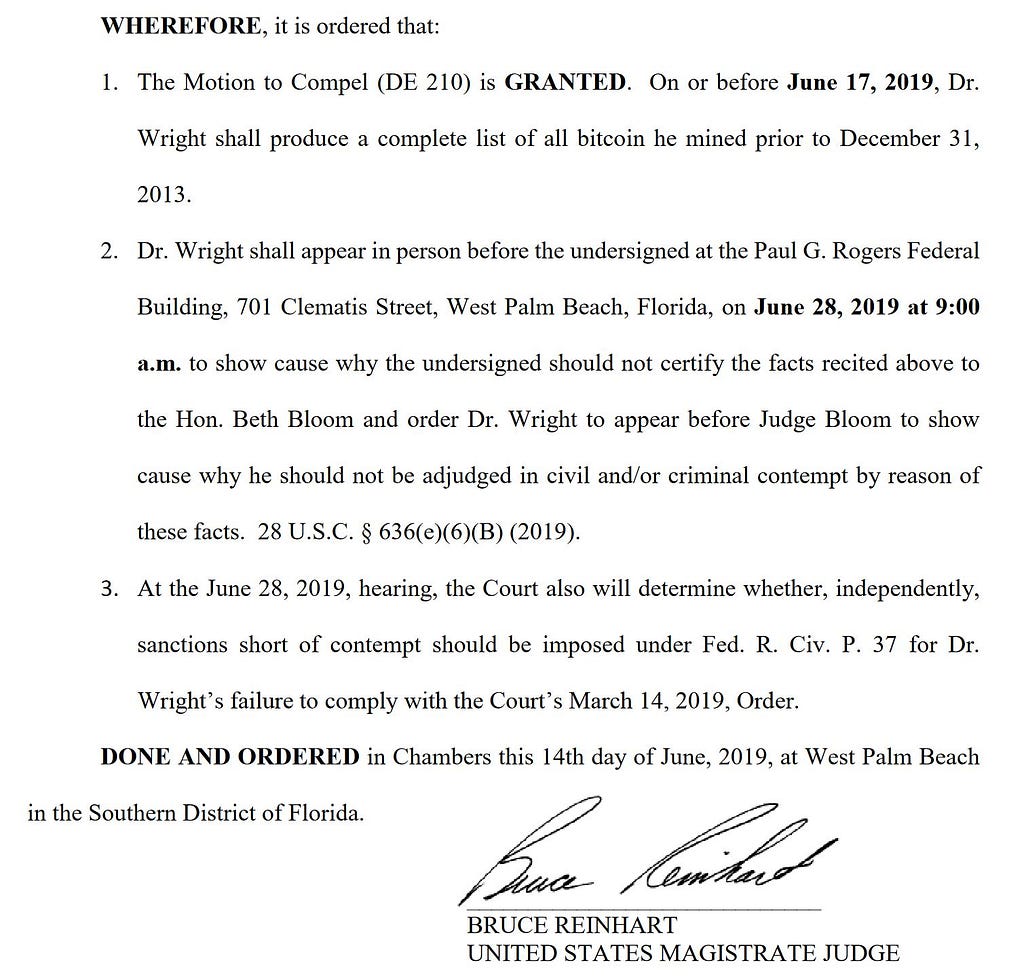
During the Evidentiary Hearing on June 28, 2019 (a full “Dr. Wright, you throw another document you will be in handcuffs so fast your head will spin. Do you understand me?” transcript can be found here on CourtListener) we learn a bit more about the numbers 1,100,111 and 821,050. From the transcript we can determine what these numbers actually represent in Craig’s Satoshi fairy tales.
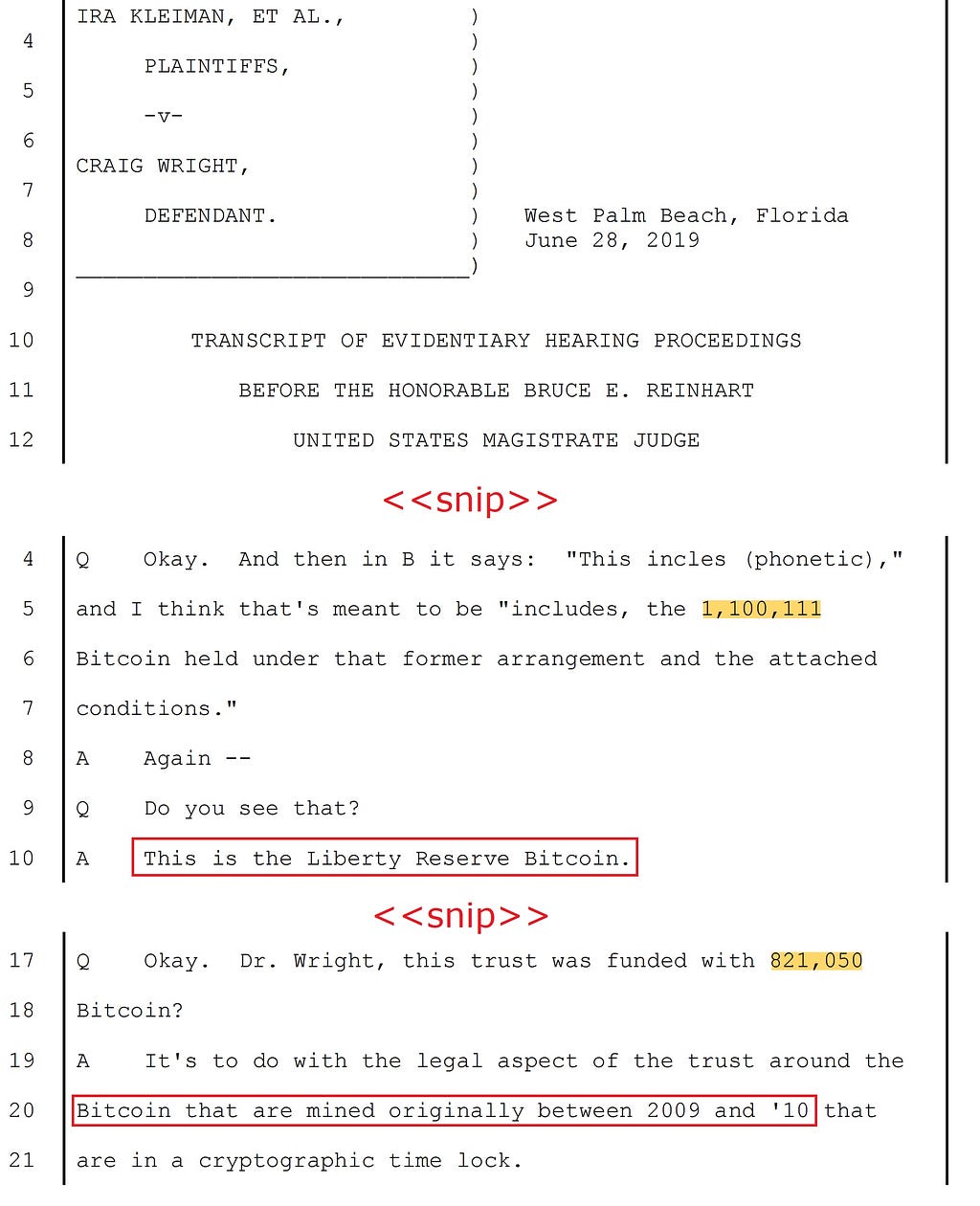
To summarize, for those who lost track of what number represents what:
- 1,100,111 is a somewhat random number that Craig Wright had chosen in 2014 for his ‘bought’ bitcoin
- 821,050 is a somewhat random number that Craig Wright had chosen in 2014 for his ‘mined’ bitcoin, representing 16,421 Bitcoin block subsidies of 50 BTC each
From now onward, we only concentrate on the number for Craig’s ‘mined’ bitcoin: 821,050. A number very, very close to 821,050 will pop up related to the infamous Tulip Trust list, the subject of this article. Now let’s check out how that all went with this list.
During this same Evidentiary Hearing on June 28, 2019 we learn that Craig Wright had recently asked his nChain colleague Steve Shadders (his real name is Steven Coughlan, by the way) to produce a list of public Bitcoin addresses that Satoshi Nakamoto, sorry Craig Wright to play along with this silly cosplay game, had possibly mined in the 2009–2010 era. At this point in time, Steve Shadders is apparently sitting on a list of almost 28,000 Bitcoin addresses, trimmed down from a list of over 75,000 Bitcoin addresses.
MS. MARKOE [from Craig Wright’s counsel]: So, Your Honor, as Dr. Wright testified, he had instructed Steven Shadders, or Steve Shadders, to try to, with some given criteria, narrow down the potential list of Bitcoin addresses that Dr. Wright could have mined. He created software and code in order to do that using specific criteria. He was going to testify about that today. He will testify about that on another day. He has engaged in that endeavor and has created a list that narrows down potential Bitcoin addresses from over 75,000 and a half to under 28,000.
THE COURT: Okay.
MS. MARKOE: So a margin of a 60 percent reduction. And we have that today. He is continuing to do some work to try to narrow that down a bit further.
THE COURT: Okay.
MS. MARKOE: But this is an inclusive list that would include all of the Bitcoin mined by Dr. Wright through his companies, but we’ll, to be fair, also include addresses that could not be excluded based on the criteria.
Now remember, this list that Steve Shadders created for Craig Wright with ‘under 28,000’ Bitcoin addresses still needs to be narrowed down to 16,421 Bitcoin addresses… And this simple fact will (also!) come back to bite Craig Wright in the ass real hard, as we will learn later. Keep reading!
During the June 28, 2019 hearing Craig also introduces the audience to another phenomenon: the bonded courier.
 The bonded courier would become one of the most popular Faketoshi memes
The bonded courier would become one of the most popular Faketoshi memes
Q: Dr. Wright, can you please explain to the Judge exactly what was done, what this technical solution is that prevents you from obtaining now a list of public addresses so that you can comply with the Court’s order and provide them.
A: The Bitcoin that was mined at the time was done as a series of derivative keys. The way this worked was the Genesis key was added to a hash chain. The hash chain is basically a hash of values that an index using a HMAC, H-M-A-C, form of function multiplied by the curve generated G. There is a separate secret for the Genesis key and for the access chain. The access chain acts as an index for each of these keys. This allows separation of mapping where the keys were generated and spending. The access to gain knowledge of what was put in the access chain and to be able to generate those keys was given to Dave to distribute, and so that I wouldn’t be in trouble, was set so that after a period, in January of next year, a bonded courier is meant to return key slices.
Q: So the manner in which it was set up with Dave Kleiman potentially allows for the fragmented keys to come to you so that you can decrypt the file and obtain a list of the public addresses; is that right?
A: That is correct.
Q: What if it doesn’t happen?
A: Then I’ll work to make more money to pay back the debt that I’ve caused by creating this.
Q: So it’s possible, if I understand your testimony, Dr. Wright, that you may never access the coins for your beneficiaries at all.
A: If I don’t access them, I will keep inventing enough patents and other technology to fund what I was going to do in my fund another way.
Q: But my question is whether you agree that it is possible you may never gain access to the coins; is that correct?
A: That’s correct.
Q: It is possible that you may never be able to decrypt the encrypted file that would allow you to run the algorithm to produce not only the list of public addresses, but access the IP; is that right?
A: That is correct.
<<snip>>
BY THE COURT:
Q: Dr. Wright, there’s an outermost encrypted file, correct?
A: Yes.
Q: Okay. How many slices do you need for that file?
A: Eight of 15.
Q: Who has them?
A: I don’t know.
Q: What efforts have you made to find them?
A: I’ve tried looking through documents, et cetera. The way it was set up was I gave slices to Dave, and he was directed to give them to bonded couriers that would send slices based on different events. One of those events was June 20, 2020, was one to be returned, or one set to be returned. I don’t know whether Dave set those up correctly. They used a DX service, which is bonded courier in this country, I guess, where you pay someone so that if an event happens, they will send the mail, a registered post for instance. I can’t ask Dave whether he did that correctly. To be able to tell the Australian tax office that I had zero control, I needed to hand over enough slices to Dave that I didn’t have control.
The quote above contains three times the mention of ‘bonded courier(s)’, but overall, no less than five times does Craig Wright mention this infamous bonded courier during this hearing.
Another occassion where Craig talked about the bonded courier was when he explained the concept to Jimmy Nguyen. Jimmy Nguyen was interviewed during the Kleiman v Wright lawsuit on May 26, 2020 and in the transcript of his deposition we can find the following conversation:
Q: When Dr. Wright was talking to you about the key shares or key slices coming back did he mention the term bonded courier?
A: At some point, yes.
Q: Did you ask him what that meant?
A: Yes, because I have never heard of the phrase before.
Q: What did he tell you?
A: He said it’s a service provider commonly used in countries like Australia, United Kingdom where you can deposit something it could be a physical thing, a package, a letter, program, information with the service that would hold it in safe and carry out instructions for it, for example a certain time or when certain conditions are met and he told me it was something he used that was commonly used by lawyers for example in other countries and that’s why I had not been familiar with this in the United States and some of those other countries.
Q: Did the name Denis Mayaka ever come up when he was discussing bonded courier?
A: Not when he was discussing the bonded courier.
Q: Did you ask him if he knew which company might have been — strike that. Did he say that Dave Kleiman leveraged the bonded courier mechanism to return to get the key slices back to Dr. Wright?
A: He didn’t say that.
Q: What did he say?
A: He said generally that he asked Dave to distribute slices of the keys necessary to access the layer of the encrypted file to multiple places and I asked him well, how would they come back. And that’s when he used the example of the bonded courier as one mechanism for which key fragments could come back in the future then he asked Dave to set up arrangements with people that are service providers like a bonded courier and asked Dave not to tell him who the arrangements were set up with.
At some point though, Craig Wright starts denying, or maybe it’s better to say backtracking, that he ever mentioned ‘bonded courier’. Not only in public like in his Slack chatroom in front of his most dedicated fans:
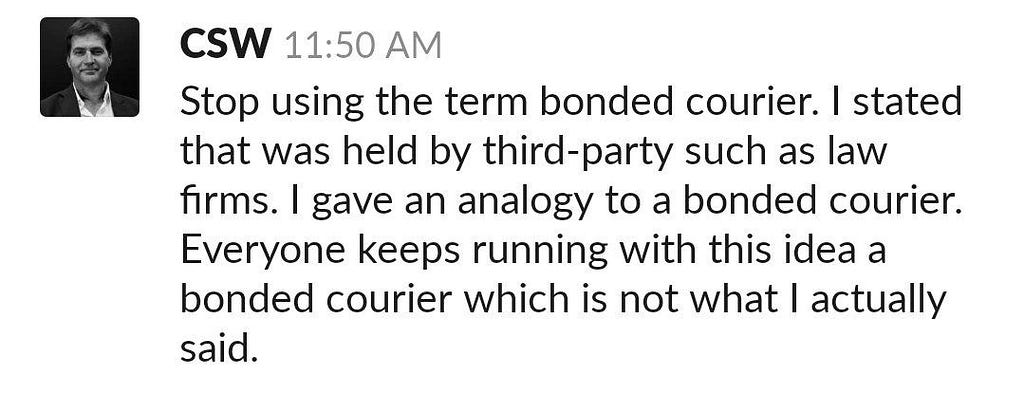
But also in his legal cases, like in the Wright v McCormack defamation lawsuit:
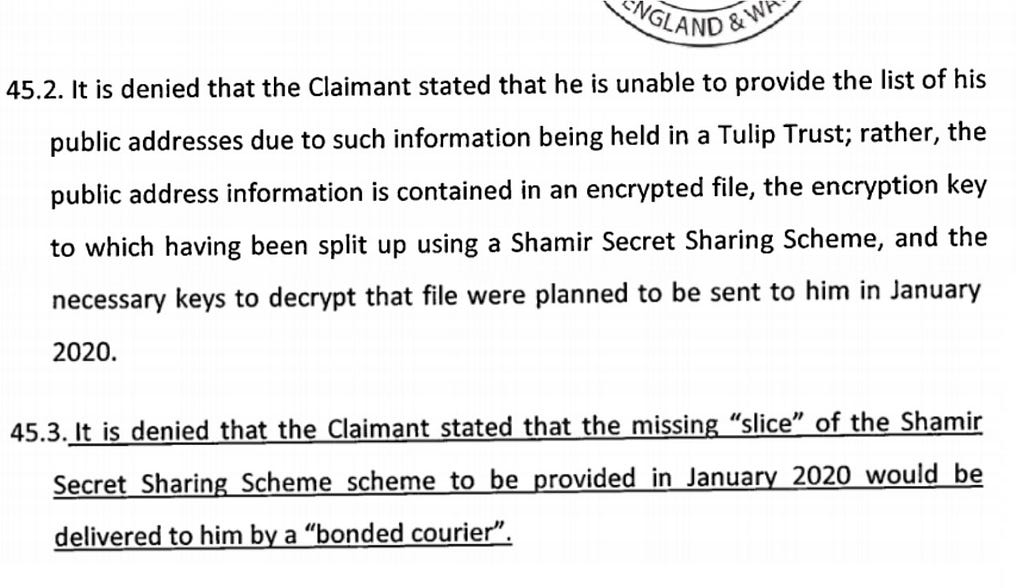
It’s perfectly clear by now though that Craig Wright, and what’s new with our cosplaying con man, is trying to rewrite history here again.
 In July 2019, Craig Wright appears certain that he would receive the 821,050 bitcoin in 2020
In July 2019, Craig Wright appears certain that he would receive the 821,050 bitcoin in 2020
On August 26, 2019 an evidentiary hearing was held in the Kleiman v Wright lawsuit, during which Judge Reinhart showed no mercy when dealing with Craig Wright’s antics so far. But first he briefly touches upon the performance of Steve Shadders.
Let me turn for a second to Mr. Shadders.
Mr. Shadders testified that he was asked by Dr. Wright to try to reconstruct Dr. Wright’s Bitcoin holdings by applying six data filters to the public Bitcoin block chain. Mr. Shadders is the chief technology officer at nChain, Limited, a Bitcoin technology company in London, where Dr. Wright is the chief scientist. Dr. Wright provide the six-filter criteria. Mr. Shadders wrote computer code to apply it and devoted approximately 12 to 16 hours to the project. His analysis identified approximately 27,000 Bitcoin public addresses that met all six criteria. Because one of the criteria was that the Bitcoin address correspond to a newly mined Bitcoin block, each public address represents 50 Bitcoin. Therefore, Mr. Shadders’ analysis identified approximately 1,350,000 Bitcoin. These could not be further distilled to identify Bitcoin controlled by Dr. Wright.
I found Mr. Shadders’ testimony about his effort to apply these filter criteria to be credible and worthy of belief. I understand the inference that Dr. Wright would not have wasted Mr. Shadders’ time if Dr. Wright were capable of complying with the Court’s order. I also accept that Mr. Shadders’ efforts demonstrate a good-faith attempt by Dr. Wright to comply. Nevertheless, for the reasons I will talk about in a moment, I give limited weight to these two inferences.
Let me turn now to Dr. Wright’s testimony.
Apparently, dead men tell no tales, but perhaps they send bonded couriers. I completely reject Dr. Wright’s testimony about the alleged Tulip Trust, the alleged encrypted file and his alleged inability to identify his Bitcoin holdings. Quite simply, Dr. Wright’s story not only was not supported by other evidence in the record, it defies common sense and real life experience. Consider the claims. Dr. Wright says he designed Bitcoin to be an anonymous digital cash system with an evidentiary trail. He mined approximately 1 million Bitcoin. There is no accessible evidentiary trail for the vast majority of them. He portrays himself as a latter day Dr. Frankenstein, whose creature turned evil when hijacked by drug dealers, human traffickers and other criminals. So to save himself, he engaged David Kleiman to remove all traces of his involvement with Bitcoin from the public record.
As part of his efforts to disassociate from Bitcoin and, quote, so that I wouldn’t be in trouble, end quote, he put all his Bitcoin and/or the keys to it, because the story changed, into a computer file that is encrypted with a hierarchical Shamir encryption protocol. He then put the encrypted file into a blind trust, of which he is the trustee, and gave away a controlling number of the key slices to the now deceased Dave Kleiman, and so therefore he cannot now encrypt the file that controls access to the Bitcoin. His only hope is that a bonded courier arrives in 2020 with the decryption keys. If the courier does not appear, Dr. Wright will lose the ability to access billions of dollars-worth of Bitcoin, and he says he doesn’t care. That’s completely inconceivable.
Turning to the factors that the Eleventh Circuit says I must consider. Dr. Wright’s demeanor did not impress me as someone who was telling the truth. When it was favorable to him, Dr. Wright appeared to have an excellent memory and a scrupulous attention to detail. Otherwise, he was belligerent and evasive. He did not directly and clearly respond to questions. He quibbled about irrelevant technicalities. When confronted with evidence indicating that certain documents had been fabricated or altered he became defensive, tried to sidestep questioning, and ultimately made vague comments about systems being hacked and others having access to his computers. None of these excuses were corroborated by any other evidence.
Dr. Wright has a substantial stake in the outcome of this case. If the plaintiffs succeed on their claims, he stands to lose billions of dollars in Bitcoin. That gives him a powerful motive not to identify his Bitcoin. As long as the relevant Bitcoin addresses remain secret, he can transfer the Bitcoin without the plaintiffs ever being able to find them. Because after all, Bitcoin is an anonymous cyber currency. In addition, Dr. Wright had very good motives not to tell the truth. Most notably, he might want to prevent the plaintiffs or others from finding his trove of Bitcoin. Alternatively, there was evidence that relevant documents were altered in or about 2014 when the Australian tax office investigation was actively — I’m sorry, when the Australian tax office was actively investigating one of Dr. Wright’s companies. Perhaps Dr. Wright’s testimony here is motivated by certain legal and factual positions he took in the Australian tax office investigation and from which he cannot now recede.
At the end of the day, his motivation doesn’t matter. His testimony is not credible on its face. As Judge Bloom recently noted, Dr. Wright has taken directly conflicting factual positions at different times throughout this litigation, and that behavior continued before me. There was substantial credible evidence that documents produced by Dr. Wright to support his position in this litigation are fraudulent and forged. There was credible and compelling evidence that documents had been altered. Other documents are directly contradicted by Dr. Wright’s testimony or his sworn declaration of May 8th. While it is true that there was no direct evidence that Dr. Wright was responsible for the alterations or fabrications of documents, there is no evidence before the Court that anyone else had a motive to falsify them. And although Dr. Edman was not permitted to testify that he believed they were fraudulent, as the finder of fact, I find them to be fraudulent, and willfully so. There is a strong and unrebutted circumstantial inference that Dr. Wright willfully created fraudulent documents.
One example is the Deed of Trust document for the Tulip Trust. Among the trust assets identified in this purported Deed of Trust, dated October 23rd, 2012, are all Bitcoin and associated ledger assets transferred into Tulip Trading, Limited by David Kleiman on February 10th, 2011. Notably absent from the list of trust assets is any encrypted file, any software or any public or private keys. The Deed of Trust states that the parties forming the Tulip Trust are Wright International Investments, Limited and Tulip Trading, Limited. There was credible and conclusively probative evidence that Dr. Wright did not control Tulip Trading, Limited until 2014, which would have been two years after the trust allegedly was formed. There was other forensic evidence indicating that the Deed of Trust document itself is fraudulent.
So the totality of the evidence in the record does not substantiate — I’m sorry. I find that the totality of the evidence in the record does not substantiate that the Tulip Trust even exists, and I find that Dr. Wright’s testimony that this trust exists was intentionally false. And although I am only required to make this finding by a preponderance of the evidence, if required to do so, I would find clear and convincing evidence to support it. Dr. Wright’s false testimony about the Tulip Trust was part of a sustained and concerted effort to impede discovery in this case. I start with his deceptive and incomplete discovery pleadings. He testified at the evidentiary hearing that at least as early as December 2018, he knew he could not provide a listing of his Bitcoin holdings, yet the Court was not told this quote-unquote fact until April 18th, 2019.
I give Dr. Wright the benefit of the doubt that prior to May 14th, the plaintiffs were seeking information that went beyond merely a list of his Bitcoin holdings on December 31st, 2013. Nevertheless, after the May 14th hearing, it was well and clear that the Court expected Dr. Wright to provide plaintiffs with sufficient information so the Bitcoin holdings could be traced. After May 14th, having lost on legal grounds, Dr. Wright changed course and started making affirmative misleading factual statements to the Court. His April 18th motion argued for the first time that he had transferred all of his Bitcoin into a blind trust, and that he was not a trustee or beneficiary of that trust, nor did he know any of the public addresses which hold any of the Bitcoin in the blind trust. This pleading was intended to communicate the false impression that Dr. Wright had no remaining connection to the Bitcoin, and it was also intended to create the impression that the Bitcoin themselves had been transferred into the trust.
Now, this was a pleading. It was not verified; it was signed by counsel. And by signing the document, counsel certified that the pleading had evidentiary support. The only source of information that could have provided the information was Dr. Wright. So I find that counsel reasonably relied upon Dr. Wright as the source of that information, and that Dr. Wright is personally responsible for the misrepresentations made in the pleading on April 18th.
As I noted earlier in discussing with Ms. McGovern, three weeks later, Dr. Wright submitted a sworn statement that contradicted the April 18th motion in which he admitted he was one of the trustees of the trust. So, clearly, his represent — one of those representations cannot be true. He also gave inconsistent sworn testimony about what is in the alleged trust. His April 18th motion states that Bitcoin had been transferred to the trust. His May 8th declaration swears that Bitcoin had been transferred to the trust. But at his deposition and at the evidentiary hearing, he changed his story and testified that what had been transferred were the keys to Bitcoin, not the Bitcoin itself.
All of this evidence cannot be reconciled; particularly, the April 18th motion and the May 8th declaration. One of them is intentionally false. The Court gave Dr. Wright an extension of time to draft and file the declaration so he could meet in person with counsel. He swore they had met, and that he had provided counsel, quote: With additional details and clarity regarding trusts that I settled that hold or held Bitcoin that I mined or acquired on or before December 31st, 2013. He further — end quote.
He further swore, quote: In June 2011, I took steps to consolidate the Bitcoin I mined with Bitcoin that I acquired and other assets. In October 2012, a formal trust document was executed, creating a trust whose corpus included the Bitcoin that I mined, acquired, and would acquire in the future. The name of that trust is Tulip Trust. It was formed in the Seychelles, end quote.
During his testimony at the evidentiary hearing, Dr. Wright made a point of being precise in his use of terms, including at one point contesting whether a document was an e-mail or a PDF of an e-mail. It is not credible that given his claim to have an intimate understanding of Bitcoin, he would have mistaken the currency for the keys that control the ability to transfer the currency. I find, instead, that he belatedly realized that any transactions transferring Bitcoin into the Tulip Trust would be reflected on the master block chain. That he would then be required to identify those transactions, which would allow plaintiffs to trace. So to avoid that, he changed his story again.
His story also changed at the evidentiary hearing, where he argued for the first time that a list of public addresses was meaningless. As I’ve noted, the Court never ordered him to produce a list of public addresses. I ordered him to produce a list of his Bitcoin holdings. His position that public addresses are meaningless or have no evidentiary value is particularly disturbing, because it was his counsel who first injected the idea of public addresses as a discovery matter. Now, admittedly, counsel answered the Court’s question without consulting Dr. Wright and without time to fully research the situation, so I do not fault counsel. But if, as Dr. Wright now asserts, his counsel was wrong, Dr. Wright, the self-proclaimed creator of Bitcoin, and therefore a person who claims to have intimate knowledge of how Bitcoin works, should have corrected the record long before the evidentiary hearing on June 28th.
Instead, in his April 18th motion, Dr. Wright explained he could not produce a list of public addresses. He never said that public addresses lack evidentiary value. This behavior continued in his May 8th declaration, where he again talked about public addresses, but never argued that they were meaningless. Although Dr. Wright may not have an obligation to correct an opposing party if its discovery request is imprecise, the Court is different, particularly where, as here, the Court’s intent was unmistakable. It was clear that the Court was ordering Dr. Wright to produce evidence to document the existence and extent of his Bitcoin holdings so that plaintiffs could attempt to trace them through the master block chain. If, as Dr. Wright now claims, the public addresses are not the proper data point to identify the Bitcoin he held on December 31st, 2013, he had an obligation to tell the Court. His delay in doing so is deceptive and intentionally misleading.
All this information is more than sufficient to warrant sanctions that I’ve discussed. However, there is also the alleged file that Dr. Wright claims is being held by the Tulip Trust which contains the information necessary to reconstruct his Bitcoin holdings. I find that file does not exist based on the evidence before me. Dr. Wright testified it is an encrypted compressed file containing multiple subfiles. He explained, quote, each of these files has a differently calculated encryption key. It’s a hierarchical system, where, based on a combination of the file hash and the original encryption key, there are a variety of those, there are multiple Shamir schemes. So, in essence, he testified it’s like a Russian nesting doll.

The Shamir scheme divides a single encryption key into multiple key slices, and some subset of those key slices is needed to decrypt a file. Dr. Wright testified that 15 key slices existed for the outermost file, but only eight key slices were needed to decrypt that file, but he only has seven, or can only access seven. After observing his demeanor and considering a lack of any other credible evidence in the record that this file exists, I find that a preponderance of the evidence exists that no — I’m sorry, I find that a preponderance of the evidence establishes that no such file exists, and that Dr. Wright’s testimony to the contrary was perjurous.
I also note as a side note that Dr. Wright testified that the key slices for the encryption of the outermost layer had to be applied in a particular order. That is not what Dr. Shamir’s paper says. According to Dr. Shamir’s paper, a Shamir scheme is decrypted by inserting each key slice into the same polynomial to create a series of linear equations, which are then solved simultaneously, not sequentially. There is no ordering or indexing of the key slices.
Now, that being said, I do not exclude the possibility that Dr. Wright could have employed a modified Shamir scheme, so I do not consider this testimony as to the ordering of the key slices in making my overall findings, but I do note it is inconsistent with Dr. Shamir’s paper.
Now, Dr. Wright argues quite forceful that he would never risk going to jail for contempt or having sanctions imposed against him if he could produce a list of his Bitcoin holdings. He argues that it would not be credible that anyone would make that choice. Equally, if not more incredible, is the idea that someone who controlled almost a million Bitcoin would encrypt it in a way he could not access it and then wouldn’t care if he lost it all.
Additionally, as discussed above, there are many reasons a person in Dr. Wright’s situation would take the risk. In sum, after days of testimony, multiple discovery hearings and lengthy pleadings, the sole evidence supporting Dr. Wright’s claim that he cannot comply with my order is his uncorroborated, incredible testimony. That is simply insufficient to meet his evidentiary burden of proving by a preponderance of the evidence that he is unable to comply.
Moreover, the totality of the evidence, including the negative inference that I draw from Dr. Wright’s not credible testimony is more than sufficient to meet the plaintiffs’ burden. Now, Dr. Wright’s counsel has also made a very forceful argument that sanctions in this case ought to be tempered by the idea that we should let the process play out. There shouldn’t be a windfall to the plaintiff for a discovery violation, and I’m mindful of that. But I also must say there is nothing, nothing more prejudicial or inimical to the American judicial system than perjury and false testimony, which I have found occurred in this case.
So I now turn to the question of a proper remedy. I begin with something I hope is obvious here. I do not find any basis, any basis for sanctions against Dr. Wright’s counsel. Although several rules of civil procedure authorize the Court to consider sanctions and attorney’s fees against counsel, there is no basis for that in this record. I have conducted numerous hearings, and I have been able to closely observe counsel’s conduct. Counsel has zealously and ethically advocated for their client. Counsel has unfailingly been candid with this Court, even when Dr. Wright’s conduct and conflicting statements have created incredibly awkward situations for counsel. I find that counsel reasonably relied on Dr. Wright as a source of information. I find that Dr. Wright alone is fully responsible for any evasion, incomplete or false representations to the Court or noncompliance with the Court’s orders. To that end, I commend his counsel for their outstanding work in this matter.
So to this day, Dr. Wright has still not complied with my order compelling discovery. Rather, as described already, a preponderance of the evidence establishes a continuing pattern of obstructive behavior, including incomplete or deceptive pleadings, filing a false declaration, knowingly producing a fraudulent trust document and giving perjurous testimony. His conduct has wasted substantial amounts of the Court’s time and the plaintiffs’ time and resources, which could have been saved. His behavior has unnecessarily protracted this litigation. I find there is clear and convincing evidence that Dr. Wright’s noncompliance is willful and in bad faith, that plaintiffs have been prejudiced in the amount of time and money and diversion that has been occasioned upon them, and particularly given the extended pattern of noncompliance and its egregiousness, a lesser sanction is not adequate to punish or ensure future compliance with the Court’s order.
Therefore, I will impose sanctions under Rule 37(b) in addition to attorney’s fees. I start with the fact that Dr. Wright’s conduct has prevented the plaintiffs from obtaining evidence that I found relevant to their claims to a partnership between Dr. Wright and David Kleiman related to the development of Bitcoin technology and the mining of Bitcoin. Plaintiffs have been prejudiced by not being able to try to pursue this theory by tracing the Bitcoin that was mined. Therefore, as a remedial measure pursuant to Federal Rule of Civil Procedure 37(b)(2)(A)(i), the Court deems the following facts to be established for purposes of this action: And, by the way, I find that no lesser sanction is sufficient than what I’m about to announce.
One, Dr. Wright and David Kleiman entered into a 50 percent 50/50 partnership to develop Bitcoin intellectual property and to mine Bitcoin. Second, it is deemed proven that all Bitcoin mined by Dr. Wright prior to December 31st, 2013, was joint property of Dr. Wright and David Kleiman at the time it was mined. Because Dr. Wright’s 10th affirmative defense relating to the statute of frauds challenges the existence of a partnership, it is inconsistent with these findings and these facts, so it is stricken. As a further punitive sanction, I deem the following facts:
One, any Bitcoin-related intellectual property developed by Dr. Wright prior to David Kleiman’s death is jointly and equally owned by Dr. Wright and by the plaintiffs. And, two, any Bitcoin mined by Dr. Wright prior to David Kleiman’s death and any assets traceable to those Bitcoin is presently jointly and equally owned by the plaintiffs and Dr. Wright. Dr. Wright’s third, fourth, fifth, sixth, seventh, eighth, second seventh affirmative defenses assert that David Kleiman surrendered has legal rights in return for shares in a corporation. These affirmative defenses are inconsistent with the facts as I have deemed them, so they are stricken. I do not strike Dr. Wright’s first, second, I think ninth, or 11th and 12th affirmative defenses. So I do not — I do not strike all of his pleadings. I do not enter a default judgment. I leave in place the affirmative defenses relating to statute of limitations, latches, res judicata and the one I can’t remember. In addition, Dr. Wright’s April 18th motion which was in substance a motion for protective order was denied, the plaintiffs’ June 3rd motion to compel was granted, and the current motion is also granted. Therefore, I will order that the plaintiffs are entitled to receive reasonable attorney’s fees and expenses related to each of those motions. I will enter a written order summarizing these findings more fully.
And with that, is there anything further that we need to take up this afternoon, Mr. Freedman?
MR. FREEDMAN: No, Your Honor.
THE COURT: Ms. McGovern?
MS. McGOVERN: No, Your Honor.
THE COURT: All right. Thank you all very much. We’ll be in recess.
(Proceedings concluded.)
* * * * *
So far for Judge Reinhart’s ruthless ruling. However, Federal Judge Beth Bloom — who affirmed Reinhart’s credibility findings in her January 10, 2020 ”Order on Appeal/Objection of Magistrate Judge Order to District Court” (*) — overruled Reinhart his ruling in part as she wanted to see more discovery.
(*) “The Court has also reviewed the transcripts from the Evidentiary Hearing held by Judge Reinhart and agrees with his credibility findings relating to Defendant. Indeed, in answering opposing counsel’s questions, the Defendant was evasive, refused to give and interpret words in their very basic meanings, was combative, and became defensive when confronted with previous inconsistencies.”
So on January 10, 2020 Craig Wright hears the following from Judge Bloom:
Finally, the Defendant argues that at minimum he “should have been afforded the opportunity to wait until [the date the bonded courier is set to come] to see if he receives the key slices to generate the list of his bitcoin holdings, which he could then provide to plaintiffs”. Defendant contends that in the event this occurs, “even plaintiffs would have to concede that Dr. Wright’s inability to do the impossible and comply with the discovery order caused them absolutely no prejudice.” Given the Defendant’s many inconsistencies and misstatements, the Court questions whether it is remotely plausible that the mysterious “bonded courier” is going to arrive, yet alone that he will arrive in January 2020 as the Defendant now contends. However, given that the Defendant maintains that he should at least be afforded this opportunity, the Court will indulge him this much.
In light of the Defendant’s representations that the bonded courier is scheduled to arrive in January 2020, the Court will permit the Defendant through and including February 3, 2020, to file a notice with the Court indicating whether or not this mysterious figure has appeared from the shadows and whether the Defendant now has access to the last key slice needed to unlock the encrypted file. In the event this occurs, and further if the Defendant produces his list of Bitcoin Holdings as ordered by the Magistrate Judge, then this Court will not impose any additional sanctions other than the ones discussed above.
In the event the bonded courier does not arrive, and the Plaintiffs are not given access to this information, which the Court has already founded directly relevant to their claims, the Court finds additional sanctions would be warranted. Specifically, pursuant Rule 37(c)(1)(B), the Court will inform the jury of the Defendant’s failure to disclose the information sought by the Plaintiffs.
See Fed. R. Civ. P. 37(c)(1)(B). The Court will also extend the discovery period, upon motion by the Plaintiffs, in order to permit the Plaintiffs to conduct additional discovery beyond the presently set discovery cutoff period. Additionally, the Court will consider any renewed discovery requests that the Plaintiff may have.
So there you have it: Judge Bloom, although very critical about the bonded courier as we just read, allows some extra time for this ‘mysterious figure to appear from the shadows’. And did the bonded courier appear from the shadows?
Yes, he did. Sort of. Within a few days after Bloom’s January 10, 2020 ruling Craig Wright’s wife Ramona received an email with ‘information’ and ‘files’ — but no private keys — from Craig’s lawyer Denis Mayaka(*), then Ramona shared this information with her husband, and then Craig handed the infamous Tulip Trust list to Ira Kleiman’s counsel with the request to keep the list under seal (meaning: not make this list available on the public CourtListener court docket).
 Source: CoinTelegraph
Source: CoinTelegraph
(*) Again reason for Craig Wright to try attorney-client privilege, causing Ira Kleiman’s counsel to remark on February 2, 2020:
To say that discovery in this case has been challenging would be a dramatic understatement. An adversary who submits false declarations, offers contradictory perjurious testimony under oath, and submits false documents that even his own counsel are forced to disavow, severely hinders the ability to seek the truth. Unfortunately, this pattern of obfuscation is now being continued through sweeping assertions of attorney-client, work-product and (recently) joint defense privileges.
And it will come as no surprise to most of my readers, I’m sure, that Judge Reinhart, apparently not a big fan of our cosplaying friend, ruled again in Ira Kleiman’s favor on March 9, 2020:
The record does not establish that an attorney-client relationship exists between Mr. Mayaka and Ms. Watts. First, as finder of fact, I disregard the Mayaka Declaration because it has not been adequately authenticated. Particularly given my prior finding that Dr. Wright has produced forged documents in this litigation, I decline to rely on this kind of document, which could easily have been generated by anyone with word processing software and a pen. Second, I accept counsel’s representation that Dr. Wright intended for his sworn interrogatory answers to affirm that Mr. Mayaka was the counsel to the Trustee of Tulip Trust III. Nevertheless, I give no weight to sworn statements of Dr. Wright that advance his interests but that have not been challenged by cross-examination and for which I cannot make a credibility determination. I have previously found that Dr. Wright gave perjured testimony in my presence. Third, the Trust document does not identify Mr. Mayaka as counsel; he is assigned a different role. See generally DE 404–3. In sum, the record does not establish that Mr. Mayaka is counsel to the Trustee of the Tulip Trust. For similar reasons, the record does not establish that Dr. Wright and Mr. Mayaka have an independent attorney-client relationship.
The Tulip Trust list itself was supposed to stay sealed meanwhile, though. However, a few months later, in late May 2020, the Tulip Trust list became public on the CourtListener court docket of the Kleiman v Wright case by accident anyway, and the undersigned made his Twitter followers aware of this fact, and, surprise surprise, within a few days no less than 145 addresses of the 16,404 addresses on the Tulip Trust list got signed.
“Craig Steven Wright is a liar and a fraud.”
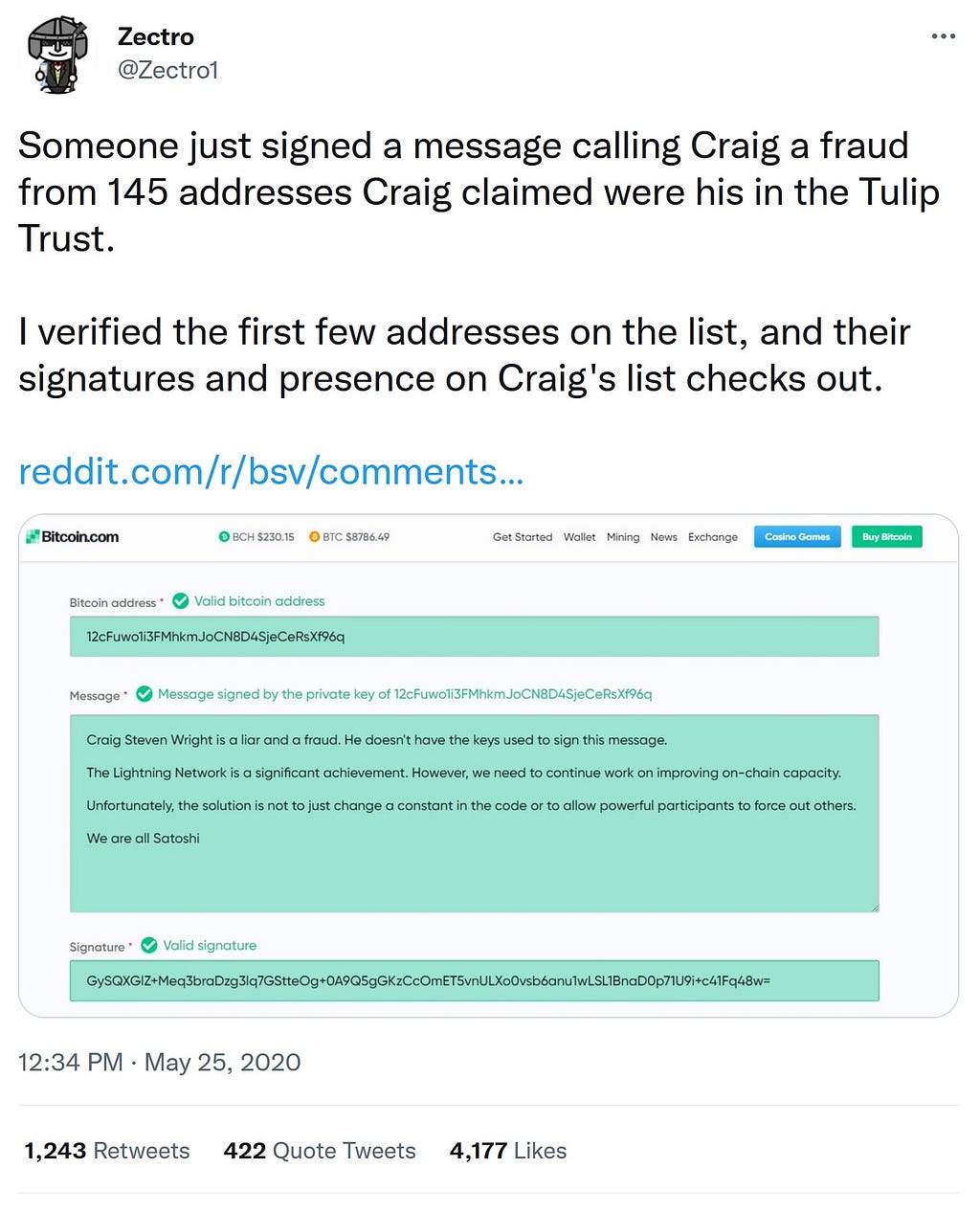 Source: Twitter
Source: Twitter
This is a perfect moment to jump into Tak_Horigoshi his very detailed thread about what happened around this mass-signing of Craig’s Tulip Trust list. On a sidenote, his tweetstorm was inspired by the following tweet of a Craig Wright apologist called ‘Streaming Sats’ who has, like many Craig Wright fans, no idea what he is talking about.
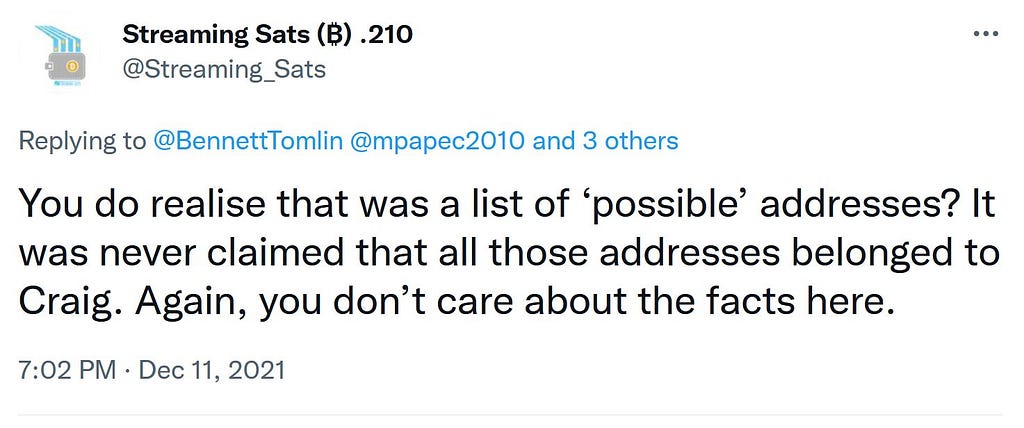 Source: Twitter
Source: Twitter
So on December 12, 2021 a not-so-amused and grumpy Tak_Horigoshi unleashed his tweetstorm. A full breakdown of his beautiful thread:
“I’m beyond tired of hearing this fake excuse from Craig Wright’s supporters. I’m going to hold your hand and walk you through this and prove it — so that there is not a shred of doubt left.
The lie: The list containing the 145 addresses that were signed “Craig Steven Wright is a liar and a fraud” was not Craig’s list of his genuine Bitcoin holdings (the “CSW Filed List”), but only on an earlier algorithm-derived list (the “Shadders List”) of addresses he MIGHT own.
The truth: The 145 addresses that were signed “Craig Steven Wright is a liar and a fraud” do in fact appear on the CSW Filed List. This list was submitted to the court in Florida by Craig as a list of his Bitcoin holdings, and he confirmed the list’s authenticity.
(Before we begin, if anyone needs a refresher on the signings, here’s a short article)
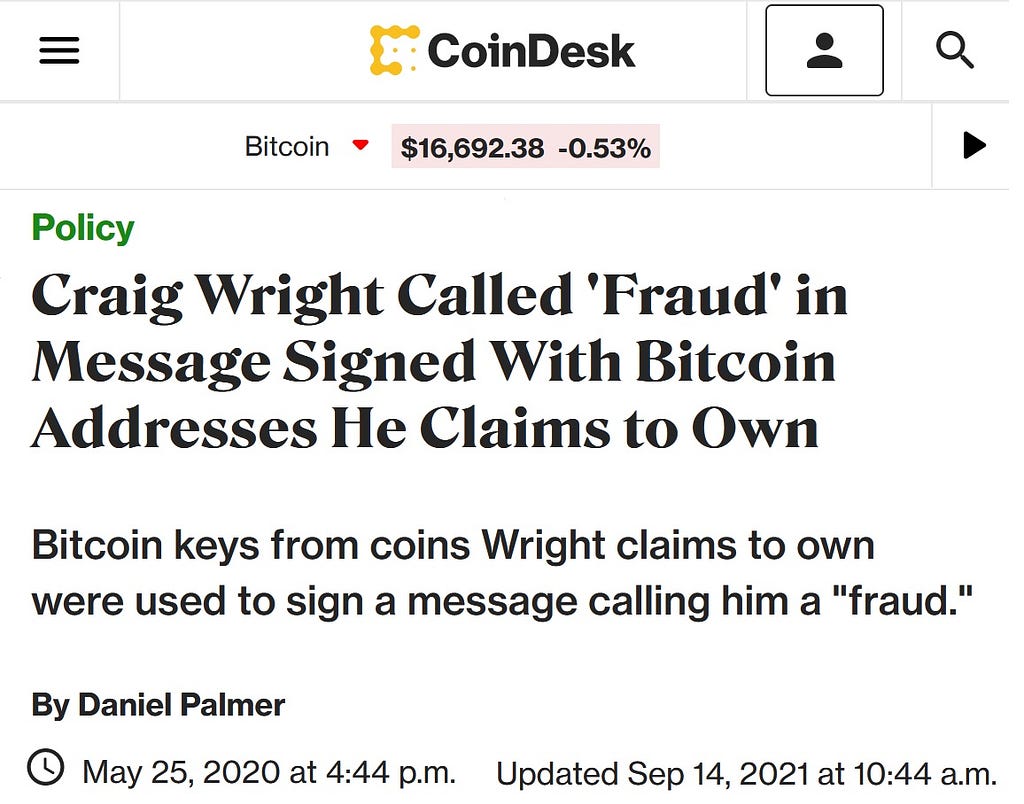 Source: CoinDesk
Source: CoinDesk
OK. Here is the CSW Filed List. Again, this list was submitted by Craig as an authentic list of his Bitcoin holdings. It was inadvertently filed by plaintiff and quickly redacted, but not before the unredacted version was grabbed by the CourtListener site.
Here is the earlier Shadders List. It was created by Steve Shadders as a list of possible addresses owned by Craig, derived by a program.
The Shadders List lists 27,973 addresses while the CSW Filed List lists 16,404 addresses. The entire CSW Filed list is contained within the Shadders List without exception. More on that later.
And here is the list of 145 addresses used to sign “Craig Steven Wright is a liar and a fraud.”
The first thing a skeptic will want to do is cross reference the list of 145 signed addresses with the addresses in the CSW Filed List. If you do so, you will confirm the addresses all appear in that list. So we’ve established that.
But the skeptic will say “how do we know this CSW Filed List from CourtListener is the real CSW Filed List?” Well, here’s how:
First, let’s compare the ECF number of our List with the ECF number referenced in the Plaintiff’s Emergency Motion to Seal (see link): It says it’s 512–7. Is that the same number at the top of the CSW Filed List? Indeed it is.
Now, let’s prove it so that there is no doubt whatever that it is the genuine CSW Filed List. Follow these steps to prove it for yourself.
Step one: Note page 21 of the Expert Report for plaintiff by Andreas Antonopoulos in which he examines the lists submitted by Craig, where Andreas notes a SHA256 sum of the CSW Filed list.
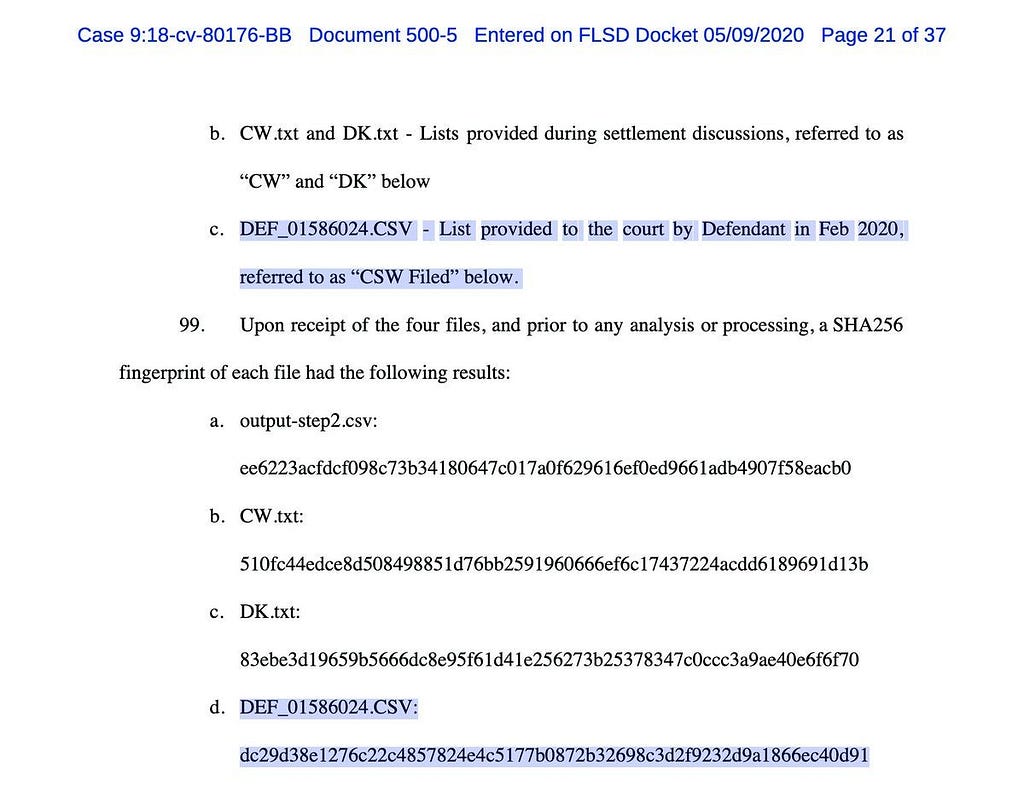 Source: CourtListener
Source: CourtListener
Step two: obtain a CSV file of the CSW Filed List. Here is a download link (combine the two sections, copy and paste to URL):
1. ht
2. tps://cswarchive.info/sites/default/files/2021–08/csw_filed.csv
(h/t @Zectro1).
Step three: Use this site to check the SHA256 sum of the file you just downloaded.
Step four: compare that sum with the sum from Andrea’s report: dc29d38e1276c22c4857824e4c5177b0872b32698c3d2f9232d9a1866ec40d91 Does it match? Indeed it does.
Voilà, you just verified the authenticity of the CSW Filed List.
So what did we prove? We proved that 1. the CSW Filed List found on CourtListener is the exact same list that Craig submitted, down to the last bit, and 2. that this list contains the same 145 addresses that were used to sign “Craig Steven Wright is a liar and a fraud.”
But now the skeptic will say “Oh ho, not so fast! You’ve established that this is the genuine List and that it was falsified by the unknown signer, but we don’t know where this list came from. How do we know it’s really a list of what Craig says are his Bitcoin holdings?”
First we’ll note that when Craig submitted the CSW Filed List, it was presented as “a list of his Bitcoin holdings”. Not, “a list of maybe’s” or “some list I randomly found in my inbox today”.
 Source: CourtListener
Source: CourtListener
But the real proof comes in this signed statement from Craig, where he describes how he says he obtained the List.
And here it is. “The receipt of these documents and my inspection of them allowed me to recognize the authenticity of the other documents, including the list of public addresses.”
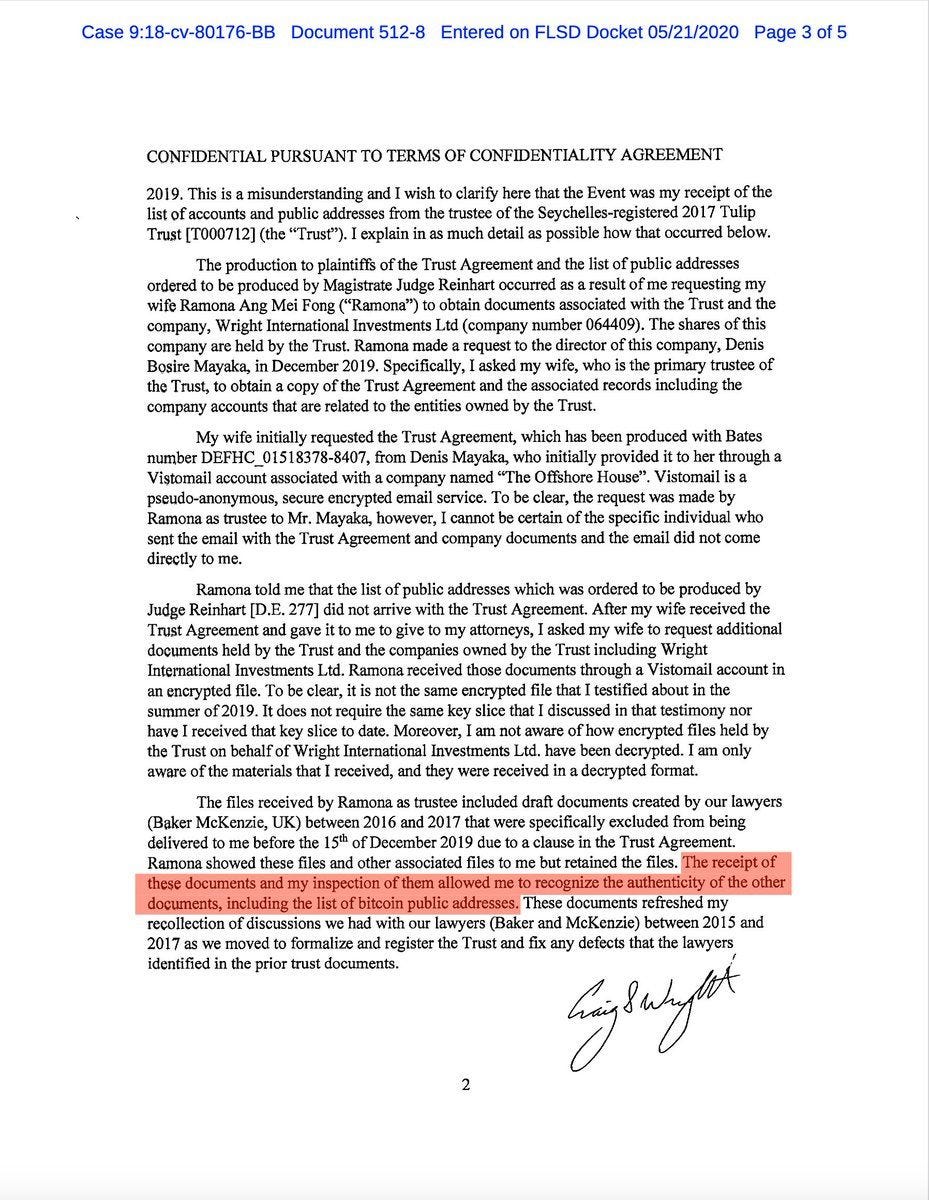 Source: CourtListener
Source: CourtListener
And there you have it. We have proven, inescapably, that Craig Wright submitted the CSW Filed List — the same list available on CourtListener — and swore to its authenticity. And we’ve proven that it contained the addresses used to sign “Craig Steven Wright is a liar and a fraud.”
p.s. All of this info has been out there, easily accessible, and was roundly discussed last year. None of it originated with me. This was only a summary h/t @btckershi and @Zectro1.
p.p.s. On the Shadders List. As noted the “Shadders List” was produced by Steve Shadders using software he wrote in an attempt to create a list of possible addresses that might be owned by Craig Wright, according to criteria set by Craig.
As described by Andreas Antonopoulos in his Expert report for plaintiffs in the Kleiman v Wright case, the program used to create the Shadders List contained a bug that misapplied the criteria and produced a set of erroneous entries.
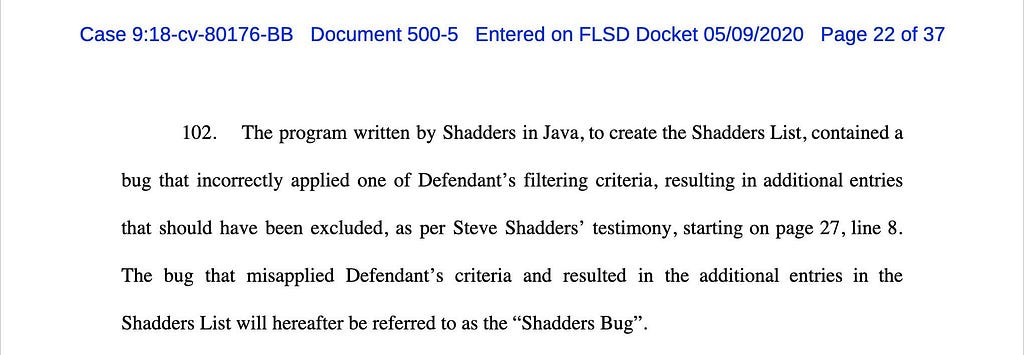 Source: CourtListener
Source: CourtListener
The same set of erroneous entries are present in the CSW Filed List, which tells us that the CSW Filed List, which is wholly contained in the Shadders List, is either derived from the Shadders List or created using the same faulty program made by Steve Shadders.
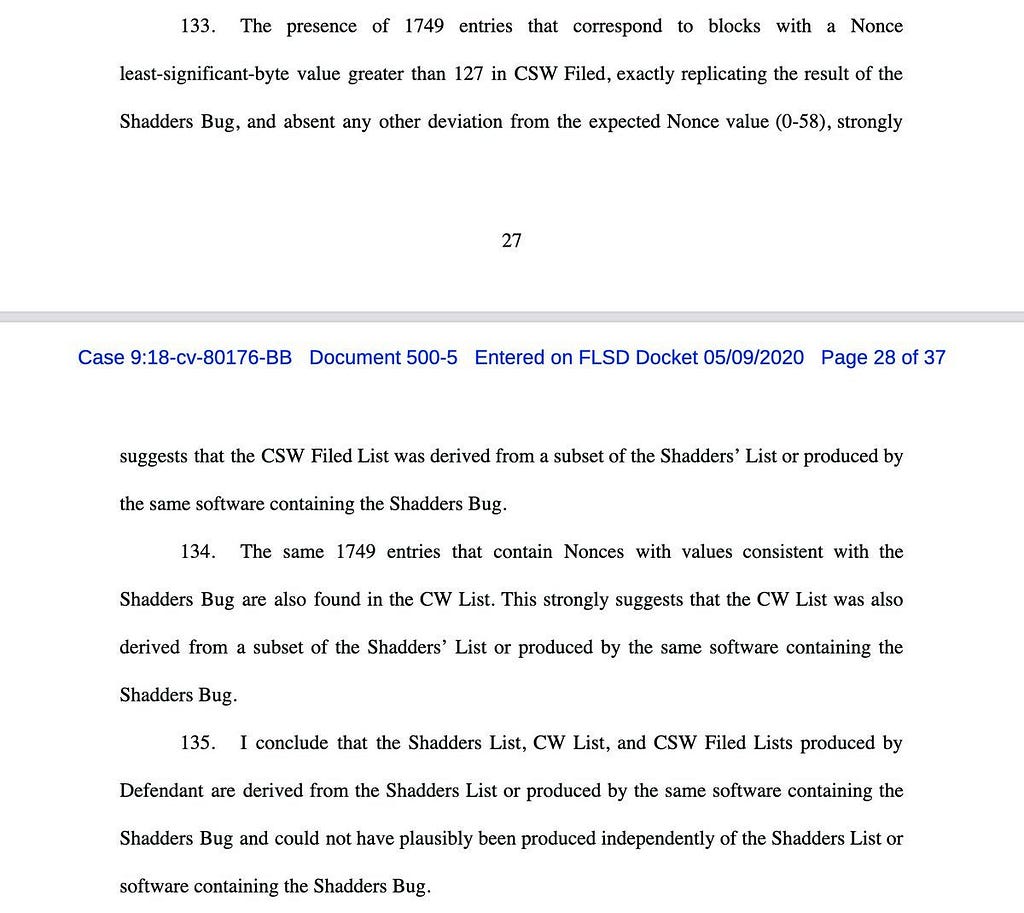 Source: CourtListener
Source: CourtListener
Either way, it proves Craig lied about the provenance of the CSW Filed List. It was not held by his lawyer for years and only delivered upon request after certain conditions were met, it was created ad hoc by Craig and Shadders in an attempt to fulfill a court order to produce a list of what Craig purported to be his Bitcoin holdings after all his attempts to put it off had finally failed and he had run out of excuses.”
So far for Tak_Horigoshi his tweetstorm.
Ultimately, the most detailed and most complete description of Craig Wright’s false antics around the Tulip Trust list forgery can be found in Ira Kleiman’s “PLAINTIFFS’ OMNIBUS SANCTIONS MOTION” dated May 15, 2020. This motion ultimately failed to get traction with the judges in Miami, but that was for legal nitty gritty reasons, not for the factually correct description of how Craig went along with his next Faketoshi forgery in a long, long line of Faketoshi forgeries that he is shamelessly dropping in his court cases.
Read it, and weep, dear reader.
II. Wright provides perjurious testimony and forged evidence in an effort to avoid compliance with Court orders
The factual background of Wright’s perjurious testimony, fraudulent evidence, and refusal to comply with this Court’s order to produce a list of his bitcoin holdings has been set forth in detail in this Court’s January 10, 2020 Order Affirming in Part and Denying in Part Judge Reinhart’s Sanctions Order. But as these forgeries and lies have continued after the Court’s order, Plaintiffs provide a summary of the relevant events for context for his continuing misconduct.
At Wright’s April 2019 deposition, he testified that
(1) he never put any bitcoin into a trust (*7); and that
(2) the Tulip Trust never came to hold the private keys to bitcoin addresses (*8).
He also testified that Dave Kleiman knew nothing about the trust, its set up, or Shamir Secret Sharing keys (*9). But demonstrated below, when offering testimony to the Court to avoid contempt and/or sanctions, Wright contradicted all three of these sworn statements. Specifically, after numerous discovery hearings, the Court ordered Wright to provide a listing of his bitcoin holdings as of December 2013. Wright filed a motion for protective order to avoid this obligation. Wright’s motion represented to the Court (directly contradicting his deposition testimony) that “[i]n 2011, Dr. Wright transferred ownership of all of his Bitcoin into a blind trust”. He also claimed he was “not a trustee or a beneficiary of the blind trust” .
Judge Reinhart denied Wright’s motion, and ordered Wright to
(i) provide a sworn declaration identifying the name, location, past and current trustees and beneficiaries of the blind trust, along with relevant contact information,
(ii) provide all documents related to the formation, administration, and operation of the trust,
(iii) all transactional records of the trust, including records showing the alleged 2011 ransfer of bitcoin — and to swear to the authenticity of these documents (*10).
Forced to provide specific details to back up representations to the Court, Wright submitted a sworn statement, that contradicted his deposition and prior motion. Specifically, he now affirmed he
(i) did put bitcoin into the trusts and that he was both
(ii) a trustee and
(iii) a beneficiary of the “blind” trusts (*11).
He further testified that he had mined bitcoin “during the years 2009 and 2010 . . . directly into a trust . . . located in Panama” that there “are no transactions related to [that] Bitcoin, and that he “transferred the encrypted files that control access to these Bitcoin in 2011, as explained below”. Wright then testified that to “[a]ccess to the encrypted file that contains the public addresses and their associated private keys to the Bitcoin that I mined, requires myself and a combination of trustees referenced in Tulip Trust I to unlock based on a Shamir scheme”. In his May 13, 2019 declaration Wright similarly swore that “the electronic files that would be used to create the private keys to the Bitcoin that I mined . . . were transferred into Tulip Trust 1. The Bitcoin itself, however, has never been transacted”.
Through these declarations Wright clearly swore that the bitcoin
(i) have never moved across the blockchain, and
(ii) remain locked in an encrypted file that can only be accessed with cooperation from Trustees.
In purported compliance with the Court’s order to produce copies of the trust documents, Wright then produced copies of three trust agreements and swore to their authenticity (*12). But we now know that Wright had not complied with the Order. Two of these documents were forgeries. And all three were purportedly rendered void by Tulip Trust 3, which he did not disclose until 7 months later.
As Plaintiffs had still not received a list of Wright’s bitcoin holdings, they moved to compel again. In response, Wright conceded he had not complied with the Court’s Order, but argued, for the first time, that compliance was “impossible”. Wright claimed (again) that the information necessary to comply with the Court’s Order was in Tulip Trust I in an encrypted file protected by a “Shamir’s Secret Sharing Algorithm”. Defendant then represented that he could not decrypt the “outer level of encryption” because he did not have all of the necessary keys, and represented that the encryption keys needed were “distributed to multiple individuals through the [blind] trusts” and “he alone does not have ability to access the encrypted file and data contained in it”. Plaintiffs demonstrated the contradictions between Wright’s deposition (no bitcoin/keys in trust) and his declarations (bitcoin/keys locked in trust). Judge Reinhart again ordered Wright to produce the list or show cause why he should not certify a contempt of court to this Court.
At the show cause hearing Wright “testified that it was impossible to comply with the Court’s Orders regarding his Bitcoin Holdings due to the Shamir Scheme implemented related to the encrypted file”. He testified that to decrypt the outer most layer of the encryption he needed eight “key slices” of which he presently claimed to only have seven in his possession. Wright testified that he simply could not produce a list of his Bitcoin Holdings even if he wanted to. Importantly, in an effort to avoid sanctions, Wright offered testimony to the Court that, again, contradicted his prior sworn deposition testimony. Specifically, while he previously testified that “Dave had . . . no knowledge of the set-up of the trust” and “did not even know what he was . . . holding” Wright now claimed that it was Dave who essentially set up the entire “trust” and that Dave was solely in charge of distributing the key slices and arranging for various bonded couriers to return the final pieces to Wright in 2020 (*13).
At the show cause hearing, Steven Coughlan a/k/a Steve Shadders (“Shadders”) testified on Wright’s behalf as to his effort to apply certain filter criteria provided by Wright to identify an overinclusive list of the Defendant’s Bitcoin Holdings. He provided that list (“Shadders List”). As will be important below, Shadders testified he made a “mistake” or “error” when applying the filter criteria. The error “was in a quirk of the particular programming language that I used . . .” which resulted in “2700” addresses being included from a “range that would have otherwise been excluded”.
Dr. Edman testified at the hearing as well. His testimony revealed that the trust documents, as well as other documents Wright produced in response to the Court’s order and that Wright had relied on to try and avoid sanctions, were forgeries. Judge Reinhart found Wright had “intentionally submitted fraudulent documents to the Court, obstructed a judicial proceeding, and gave perjurious testimony”. He found “clear and convincing evidence” to support these findings. He also found “Wright’s testimony that this Trust exists was intentionally false” and “part of a sustained and concerted effort to impede discovery into his bitcoin holdings”. He found “clear and convincing evidence” demonstrating that “no such [Shamir encrypted] file exists” and that Wright’s testimony it did was “intentionally false”. Finally, he found a “strong, and unrebutted, circumstantial inference that Dr. Wright willfully created the fraudulent documents”.
Judge Reinhart then imposed sanctions under Fed. R. Civ. P 37 deeming the following facts established:
- that Wright and David Kleiman entered into a 50/50 partnership to develop Bitcoin intellectual property and mine bitcoin;
- that any bitcoin mined or IP developed prior to David Kleiman’s death
was property of the partnership, and that Plaintiffs retained an ownership interest in the Partnership’s bitcoin and any assets traceable to them.
Judge Reinhart found “clear and convincing evidence that Dr. Wright’s non-compliance with the Court’s Orders is willful and in bad faith, that Plaintiffs have been prejudiced, and (particularly given the extended pattern of non-
compliance and its egregiousness) a lesser sanction is not adequate to punish or to ensure future compliance with the Court’s Orders” (*14).
On August 27, 2019, Defense counsel produced DEF_00560316 which she described as “the encrypted file that Dr. Wright has testified about”. Shortly, after this order, Wright’s counsel represented that an anonymous source had produced two lists of bitcoin to Wright’s contacts, one bearing the name DK (“DK List”) and the other CW (“CW List”). Defense counsel said they believed this reflected bitcoin owned by Kleiman and Wright respectively.
Settlement discussions ensued between the parties which resulted in some delay. The settlement ultimately failed as Defendant could no longer finance the non-binding agreement reached between the parties. After settlement failed, Wright objected to the sanctions order and reiterated that the list of bitcoin “is in an encrypted file that is protected by a Shamir encryption scheme . . . To unlock the encrypted file, Dr. Wright would need at least 8 of the 15 key slices, but he has only 7. Dave Kleiman, set up a system whereby Dr. Wright would . . . start to receive the remaining key slices in January of 2020 by bonded courier . . .”.
This Court “agree[d] with [Judge Reinhart’s] credibility findings relating to Defendant”. While the Court found that sanctions were warranted, it vacated the Deemed Facts because even if they “remain[ed] established, the discovery abuse remains ‘uncured’ because the amount of bitcoin owned by the Defendant remains unknown, or at the very least, still at issue”. Finally, while the Court “question[ed] whether it is remotely plausible that the mysterious “bonded courier” [was] going to arrive”, it agreed to “indulge” Wright and provided him until February 3, 2020 to “file a notice with the Court indicating whether or not this mysterious figure has appeared from the shadows and whether the Defendant now has access to the last key slice needed to unlock the encrypted file”. The Court told Wright it would leave sanctions at just attorney’s fees if the courier arrived, but if not, the Court would “inform the jury of the Defendant’s failure to disclose the information sought by the Plaintiffs”.
Pursuant to Judge Reinhart’s order on attorney’s fees and costs, Wright eventually paid Plaintiffs $165,800.09.
III. Wright submitted new lies and forgeries directly to this Court to avoid sanctions and to prevent Plaintiffs from proving their case
To everyone’s surprise, just four days later, Wright filed a Notice of Compliance “that a third party ha[d] provided the necessary information and key slice to unlock the encrypted file, and Dr. Wright has produced a list of his bitcoin holdings, as ordered by the Magistrate Judge, to plaintiffs today”. The notice was signed, pursuant to Rule 11, by counsel to Wright. On that date, Wright also provided Plaintiffs with DEF_01586024, a list of 16404 public addresses he claimed were his list of bitcoin holdings (“CSW Filed List”).
But the Notice of Compliance was an egregious misrepresentation directly to the Court.
Discovery granted by this Court ferreted out that no “key slice” had been turned over as claimed, the encrypted file was never unlocked as claimed, and no bonded courier had ever arrived. Instead, Wright’s wife requested a copy of Wright’s bitcoin holdings from an alleged Kenyan lawyer who provided her with a new encrypted file that contained a list of Wright’s bitcoin holdings (*15). The notice was a clear attempt to deceive the Court.
But that’s not all. As explained below, the CSW Filed List is yet another forgery created after this Court’s sanction order that doesn’t constitute an accurate list of Wright’s bitcoin (*16). First, despite Wright’s testimony in June of 2019 that his bitcoin are locked away in a multi-level encrypted file, which he swore, repeatedly, he cannot access, four addresses on the list have spent bitcoin since July 2019 and as recently as May 13, 2020 (*17). To be clear, it would be impossible to spend these bitcoin without access to the private keys Wright has testified unequivocally he still does not have access to.
This alone, is incontrovertible evidence that Wright has either
(i) submitted a fraudulent/incomplete list of his bitcoin as the CSW Filed List and/or
(ii) he does have access to a list of his bitcoin and the private keys associated with them and is lying about and hiding that information to prevent Plaintiffs from using the list to prove a partnership, the amount of bitcoin at issue, and to eventually trace those assets.
Further evidence Wright is concealing his bitcoin holdings is that two of the bitcoin “transactions” that spent the supposedly inaccessible bitcoin from the CSW Filed List also simultaneously spent bitcoin that are not included on the CSW Filed List and sent them all to one recipient address; this strongly suggests that whomever has the private key to the bitcoin on the CSW Filed List (Wright) also controls bitcoin that are not on the CSW Filed List (Wright) (*18).
Second, the CSW Filed List is not an independent accounting record that predates the sanctions order but a recent fabrication derived from the Shadders list. We know this because Shadders testified that one of the filters Wright told him to apply to identify Wright’s bitcoin was to ensure the “Nonce marker byte” in the bitcoin “block header” was between 0 and 58. In other words, Shadders testified Wright told him that all of his bitcoin had a nonce marker byte between 0 and 58. Shadders testified, however, that due to a highly technical “quirk of the particular programming language that I used” he had made a “mistake” or “error” that resulted in the Shadders list erroneously also including bitcoin where the Nonce marker byte was also between 128 and 255; this error erroneously added ~2700 addresses to the Shadders List (the “Shadders Bug”).
Fast forward to January of this year to the miraculous delivery of the CSW Filed List. The CSW Filed List contains 14655 blocks where the Nonce marker byte falls between the expected 0–58, which would be consistent with Shadders testimony about what Wright had told him. Inexplicably, however, it also contains 1749 entries where the Nonce marker byte falls between 128–255 — an exact replica of the Shadders Bug. In other words, it now includes bitcoin Shadders testified was not held by Wright. To be sure, the CSW Filed List contains no blocks in the 59–127 range, i.e., it contains no blocks that don’t mimic either Wright’s criteria or the Shadders bug.
The unique method for how the Shadders Bug was introduced (a “quirk” of the software Shadders used in 2019 that tells the computer how to interpret certain numbers) leads to the inescapable conclusion that the CSW Filed List is not a genuine record independently created in circa 2010 that coincidentally replicates the exact “quirky” bug Shadders introduced nine years later in 2019, but is a list Wright created from the Shadders List in 2020 and submitted to Plaintiffs. Plaintiffs’ expert concluded the same.
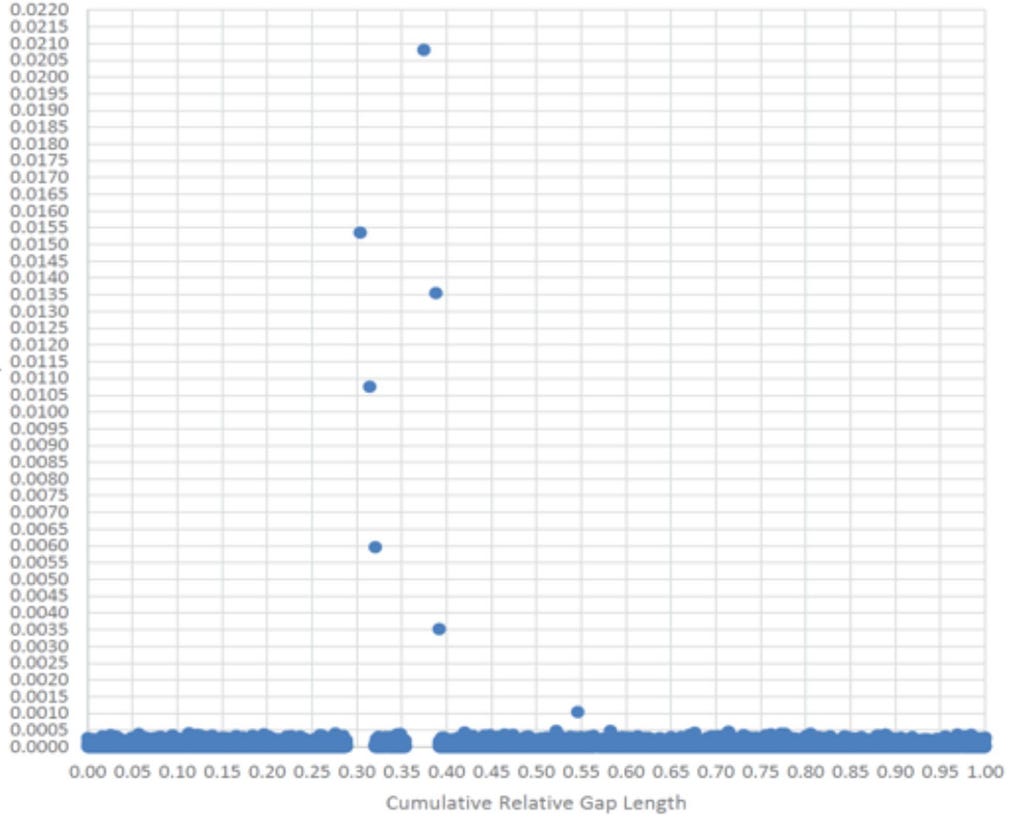
Third, the list’s transaction IDs provide irrefutable statistical evidence that it is not the result of someone having mined 16404 blocks on the bitcoin blockchain. Bitcoin Transactions IDs are created by putting the transaction information through a SHA-256 hashing algorithm twice. SHA-256 hashing results in a 64-character alphanumeric output that is uniformly distributed across the range of possible values (0 to 2²⁵⁶ — 1).
But the Transaction IDs on the CSW Filed List are not uniformly distributed. Instead, when they are ordered from smallest to greatest (this takes some mathematical conversions) and plotted across a graph, two large unnatural “gaps” appear. (figure 1 above pictorially representing the gaps). There are only three Transaction IDs in each of those gaps. Given SHA-256’s uniform distribution, there should have been 566 transactions in the first “gap” and 668 transactions in the second. The likelihood that this gap would occur as a natural result of bitcoin mining (as Wright claims) is less likely than the odds of winning the jackpot in the Powerball lottery 31 times in a row. Finally, the CSW Filed List does not include addresses “that are publicly known to have been mined and then spent by Satoshi”. Wright’s list is clearly a fabrication, most likely created by, inter alia, taking the Shadders list, sorting it by Transaction ID, deleting two large swaths of addresses, and then resorting the list by block height to obfuscate the fraud. In sum, contrary to the representations in Wright’s false Notice of Compliance, he has not heard from the “bonded courier” (as this Court predicted), not opened the encrypted file, and has still not produced a complete and accurate list of his bitcoin holdings. Instead, he produced another forgery, in an effort to deceive the Court into believing he had complied with its order.
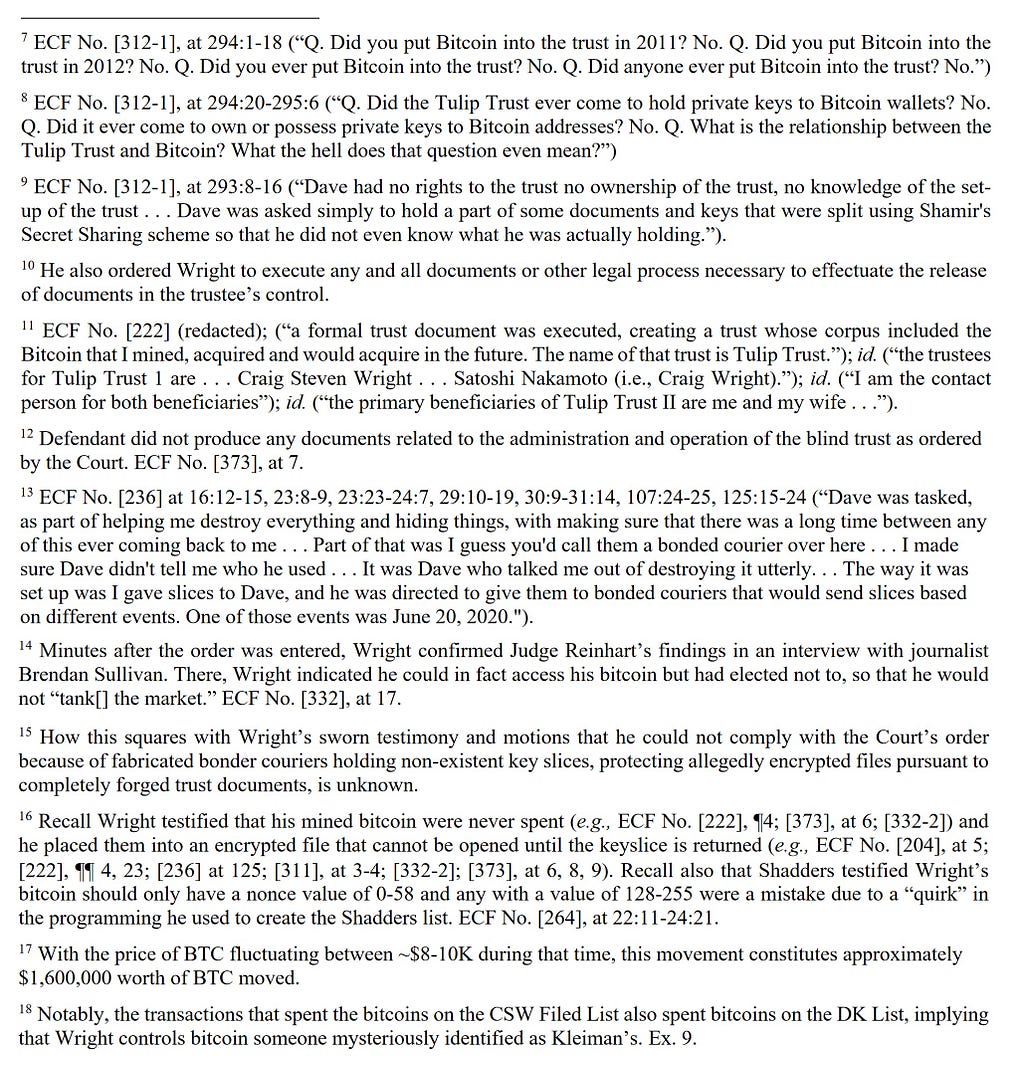 Footnotes
Footnotes
And Ira Kleiman’s “REPLY IN SUPPORT OF PLAINTIFFS’ OMNIBUS MOTION FOR SANCTIONS” dated June 8, 2020 continues with:
B. Wright perpetrated a fraud on the Court by repeatedly fabricating evidence, perjuring himself, and submitting a false notice of compliance to avoid sanctions
Wright cites thirteen cases (at 4–5) to support his claim that perjury and fabricated evidence cannot constitute fraud-on-the-court, but eleven concerned motions to set aside judgments under FRCP 60 (*4). But “fraud on the court” has a narrower meaning in the context of FRCP 60(d)(3), which is a savings clause for setting aside a fraudulently procured judgment after a year (*5). But that does not mean “creating fraudulent documents, making false statements, or committing perjury does not constitute a fraud on the court” (Opp. at 4) punishable by default sanctions.
There is a difference between proving a completed “fraud on the court” that justifies setting aside final judgment and exposing an “attempted” fraud on the court that merits default during litigation. Outside Rule 60, fraud on the court resists a strict definition, but is fairly characterized as when a “party has sentiently set in motion some unconscionable scheme calculated to interfere with the judicial system’s ability impartially to adjudicate a matter by improperly influencing the trier or unfairly hampering the presentation of the opposing party’s claim or defense”. Vargas, 901 F. Supp. at 1579.
A party that fabricates evidence to “enhance” its case is acting “in bad faith and with improper purpose in a manner which jeopardizes the integrity of the judicial system”. Id. at 1580 (citation omitted). “When a party fabricates evidence purporting to substantiate its claims, federal case law is well established that dismissal is appropriate”. McDowell v. Seaboard Farms of Athens, Inc., 1996 WL 684140, at *2 (M.D. Fla. Nov. 4, 1996).
The evidence is overwhelming that Wright “set in motion some unconscionable scheme” to both “improperly influenc[e] the trier” and “unfairly hamper” Plaintiffs’ claims through a sustained pattern of forgeries and perjury directed at the Plaintiffs and the Court. Vargas, 901 F. Supp. at 1580.
He has repeatedly manufactured evidence designed to perpetrate a fraud on the Court and secure dismissal of this action on jurisdictional grounds:
• In support of his motion to dismiss on personal jurisdiction, Wright perjured himself by submitting a sworn declaration disclaiming a relationship with W&K.
• In support of his motion to dismiss for forum non conveniens, Wright perjured himself swearing he had “no documents” from “any ATO investigation”.
• In support of his motion for judgment on the pleadings Wright submitted two forged exhibits.
• In response to direct Court orders, Wright submitted forged trust documents, swore to their authenticity, and provided perjured testimony.
• In support of his motion for summary judgment, Wright relied on a divorce settlement that he forged since neither the Australian court, he, nor his ex-wife possessed a copy of it until he “found it” (*6).
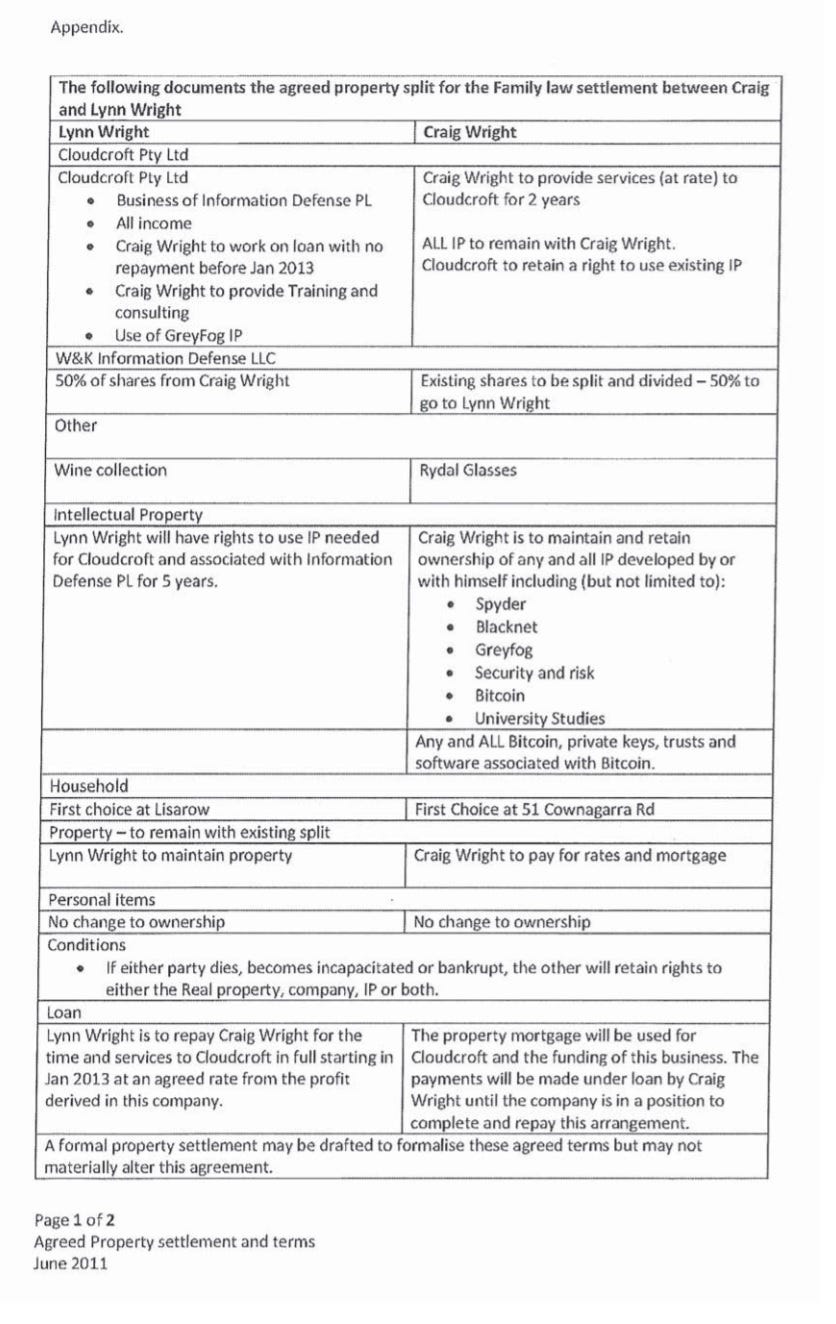 Divorce settlement forgery. Source: CourtListener, further explained in “The BlackNet Lie”.
Divorce settlement forgery. Source: CourtListener, further explained in “The BlackNet Lie”.
But perhaps the best example is his submission of a false “notice of compliance” and the fabricated bitcoin list designed to avoid sanctions for his failure to comply with discovery orders.
Specifically, the Court had stated that:
“[i]n light of the Defendant’s representations that the bonded courier is scheduled to arrive . . . the Court will permit the Defendant . . . to file a notice with the Court indicating whether or not this mysterious figure has appeared from the shadows and whether the Defendant now has access to the last key slice needed to unlock the encrypted file. In the event this occurs, and further if the Defendant produces his list of Bitcoin Holdings as ordered by the Magistrate Judge, then this Court will not impose any additional sanctions other than the ones discussed above”.
In other words, the Court specifically said Wright’s sanctions would only be lifted if:
(1) the “bonded courier . . . appeared from the shadows”,
(2) provided the “last key slice”,
(3) that “unlocks the encrypted file”, and
(4) Wright also produces his list of Bitcoin Holdings.
But:
“In the event the bonded courier does not arrive, and the Plaintiffs are not given access to this information, which the Court has already found directly relevant to their claims, the Court finds additional sanctions would be warranted. Specifically, pursuant Rule 37(c)(1)(B), the Court will inform the jury of the Defendant’s failure to disclose the information sought by the Plaintiffs”.
Desperate to avoid sanctions, however, Wright filed a notice of compliance falsely representing “that a third party has provided the necessary information and key slice to unlock the encrypted file, and Dr. Wright has produced a list of his bitcoin holdings . . . to plaintiffs today”.
But, the bonded courier never arrived, the key slice was never delivered, the encrypted file remains locked, and the list of bitcoin produced was a fabrication.
Obviously, Wright knew the bonded courier didn’t arrive. His counsel knew too because they carefully constructed the notice of compliance to state that a “third party” delivered the information and purposely avoiding saying “bonded courier”. But Wright failed to tell the Court the “bonded courier” had not come, and that he’d managed to get access to a list of his bitcoin through his alleged Kenyan counsel. Wright’s opposition doubles down on this purposeful misdirection, arguing he did nothing wrong since “the notice never stated the information was provided by bonded courier”.
Then, when “complying” with the Court’s order to say “whether the Defendant now has access to the last key slice needed to unlock the encrypted file”, the notice falsely informed the Court that the third party had provided the “key slice to unlock the encrypted file”.
These were both lies. The key slice was not provided and the encrypted file remained “locked”. Instead, Wright claims he obtained the list because upon request his Kenyan lawyer provided his wife with a different encrypted file that also contained the list. Wright’s opposition has the chutzpah to suggest (at 21) the notice was accurate because “the notice didn’t identify any specific encrypted file”. As if the notice’s reference to “the” encrypted file that could be opened with a “key slice” could refer to anything other than the one the Court referenced in its order, that the parties had spent three days of evidentiary hearings on, and submitted extensive briefing on for months. That argument is preposterous.
Wright offers no real excuse for filing this false claim to have received the “key slice” other than a general allusion to his Autism diagnosis (itself a false, desperate, and insulting attempt to excuse outright fraud).
Wright closed his fraudulent notice to the Court with a statement that he had “produced a list of his bitcoin holdings” to Plaintiffs, which was just a new round of blatant lies and fabrications. All these misrepresentations were calculated to avoid the sanctions this Court said were necessary.
Wright now appears to walk back the list’s legitimacy by claiming it’s what he “believed to be his bitcoin”, but at the time he produced it there were no such qualifiers. Wright swore in an interrogatory that “I created” the list “in or around August 2010” and that he “recognize[d] the authenticity of the . . . list . . .”. At his deposition he testified that he’d mined those bitcoins, that “[a]ll the bitcoin on that list belonged to Wright International Investments” and that “none have been spent” since the trust was established in 2011 (*).
(*) Note Arthur: This is a blatant lie by Craig Wright again. Up until Januari 2021, I kept a list of spends from the Tulip Trust list forgery. And after this list of 8 public Bitcoin addresses was created, another handful of addresses from the Tulip Trust list forgery had their block subsidies of 50 BTC move out. Feel free to ‘don’t-trust,-verify’ the following Bitcoin addresses with any block explorer against the Tulip Trust list forgery still available on CourtListener:
- 1Cm4ZiSHwaxK6rT7cbqhWtxTGjcbSrWFzp (block 57585) — 50 BTC moved out on July 8, 2019
- 18cLVrEcjvZVCifZNGXA7spJBAGkjP5fd6 ( block 63790) — 50 BTC moved out on July 8, 2019
- 1EMLQWjhgkMeA9nN6mxZVQNVcBX3joDG5M (block 67690) — 50 BTC moved out on September 2, 2019
- 1Lgifz1ujJPUabzM7e25D8kKcpNqB9Czmc (block 66680) — 50 BTC moved out on May 13, 2020
- 16qvrdawnsSQq68zfbT25xKKy2DePgPXwS (block 70894) — 50 BTC moved out on November 6, 2020
- 1JCR2VJJVv5x3g8QEyPhSFpx3XTQoigGgC (block 49428) — 50 BTC moved out on January 3, 2021
- 1L4QX44JMT8Pn6Ga5AyiY8AZyRr6vG4cot (block 49664) — 50 BTC moved out on January 3, 2021
- 1DGWivpu9x1ZFkYJvhS91o1zp851CguPXB (block 67157) — 50 BTC moved out on January 14, 2021
Back to Ira Kleiman:
This was clearly an “unconscionable plan designed to improperly influence the court in its decision” not only on jurisdiction, but on how to instruct the jury on sanctions the Court thought were otherwise necessary. Tarasewicz, 2016 WL 3944176, at *4. And his “duplicitous actions during the course of litigation” leave no room to doubt that he “attempted to perpetrate a fraud upon [the Court] with the filing of the” false notice of compliance, providing a false list, and otherwise forging and perjuring himself. Fitzpatrick v. Immune Techs., L.L.C, №05–80594-CIV, 2007 WL 9707027, at *2 (S.D. Fla. Feb. 12, 2007).
 Footnotes
Footnotes
However, as said before, this motion for summary judgment of Ira Kleiman failed as Judge Bloom ruled on June 24, 2020 in her “ORDER”:
Upon review of the record and careful consideration of the parties’ briefings, the Court does not find that Plaintiffs have carried their burden to remove this case from the jury by striking Defendant’s pleading and entering a default judgment as a sanction. To be sure, Plaintiffs depict unsettling issues that cast doubt regarding whether, since the Objections Order was entered in early January 2020, Defendant has committed perjury, produced forgeries, and engaged in judicial abuse. Further, the Court acknowledges and certainly appreciates Plaintiffs’ frustrations based on the events delineated in the briefings. However, these frustrations and doubts aside, significant factual disputes abound regarding the evidence presented, the role and importance of various pieces of evidence in the case, Defendant’s intentions, and the credibility of witnesses. These determinations, and factual inferences and legal conclusions to be derived from them, are best suited for a jury to make as fact finder at trial, not for the Court to make.
And that’s how the Kleiman v Wright case ended up with a trial in November 2021 anyway, after which the Trial Jury ruled in December 2021 that Craig Wright has to pay $100,000,000 for ‘Conversion’. Early 2022 Judge Bloom added another $43,000,000 (rounded) for prejudgment interest to this amount, indebting Craig Wright for a total of $143,000,000 after the Kleiman v Wright lawsuit.
And Craig Wright? Not only did Craig not pay a penny of this amount so far, he also found a new, nothing short of delusional, narrative meanwhile: there was no Tulip Trust list signing. Yes, you read that correctly:
THE TULIP TRUST LIST WASN’T SIGNED. 🤦♂ ️
We find Craig Wright stating this nonsense on camera (and note how he waves with his finger for a split second, for someone to call him to save him from the awkward questioning):
Peter Scott-Morgan 13%er on Twitter: "That moment when your lawyer / agent calls to get you out of hot water: pic.twitter.com/g9uWcUIBZv / Twitter"
That moment when your lawyer / agent calls to get you out of hot water: pic.twitter.com/g9uWcUIBZv
And yeah, the media picked up on this silliness too.
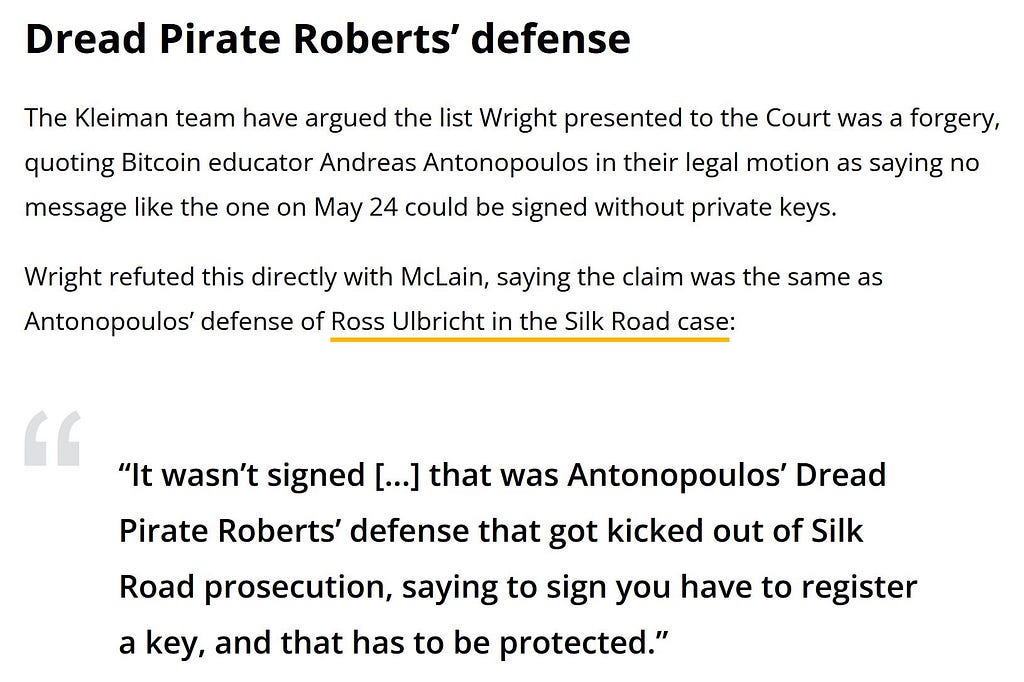 Source: CoinTelegraph
Source: CoinTelegraph
Anyway. No doubt this story of the Tulip Trust list forgery does not end here after mapping out the meat of the whole saga, so please allow me to close this article for the moment with “TO BE CONTINUED!”.
Okay, that’s all, folks. Thanks for reading!

Join Coinmonks Telegram Channel and Youtube Channel learn about crypto trading and investing
Also, Read
- 3Commas Review | Pionex Review | Coinrule review
- Ledger vs Ngrave | Ledger nano s vs x | Binance Review
- Crypto Trading bots | Bingbon Review
- Bybit Exchange Review | Bityard Review | Jet-Bot Review
- 3Commas vs Cryptohopper | Earn crypto interest
Craig Wright’s Tulip Trust List Forgery — A Full History was originally published in BLOCK6 on Medium, where people are continuing the conversation by highlighting and responding to this story.





